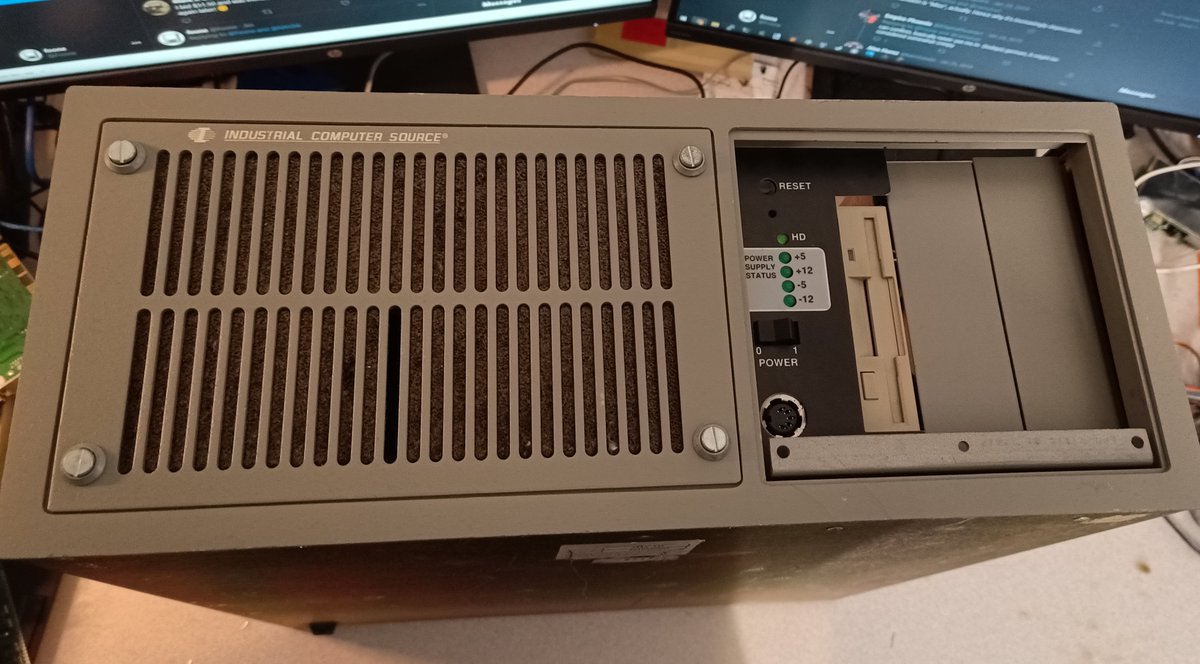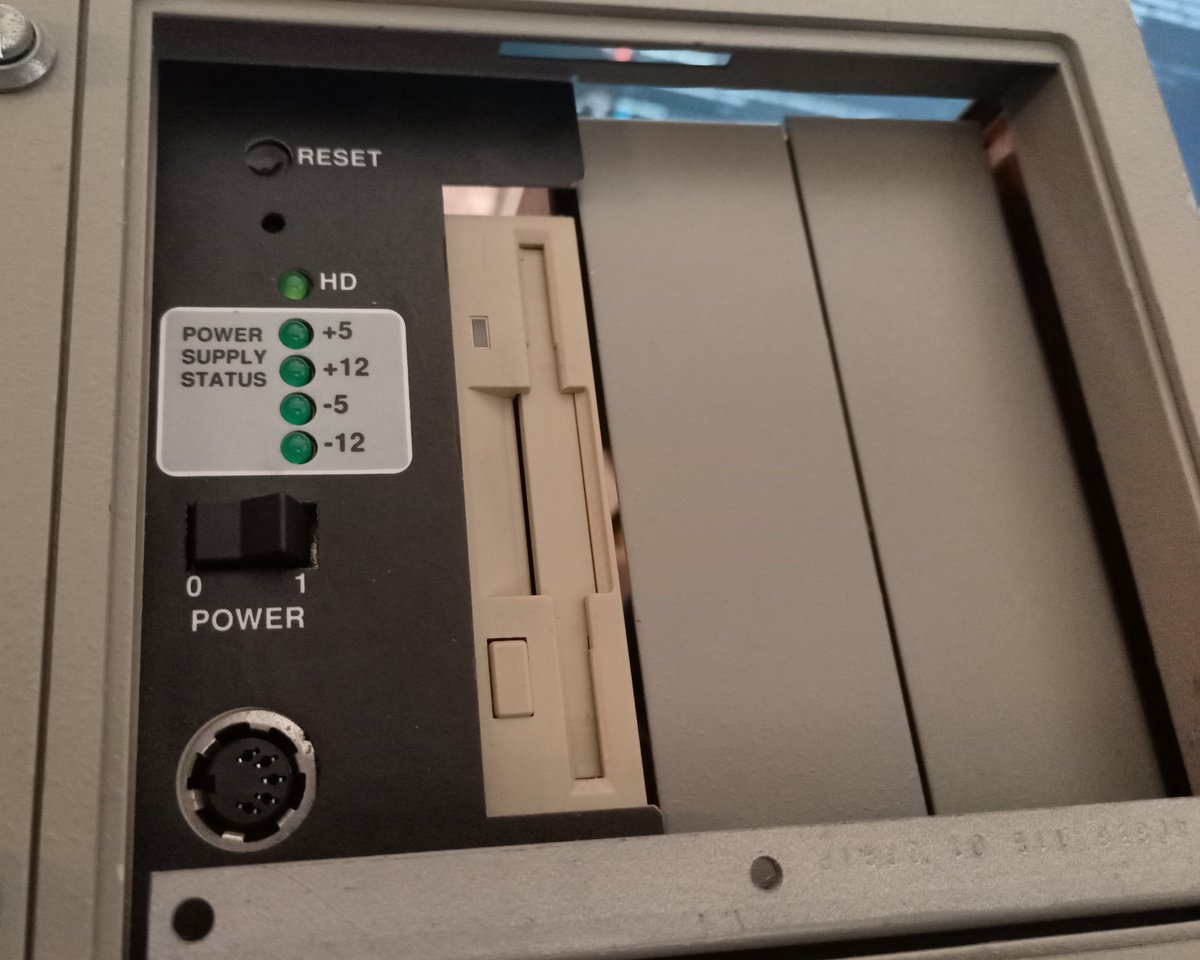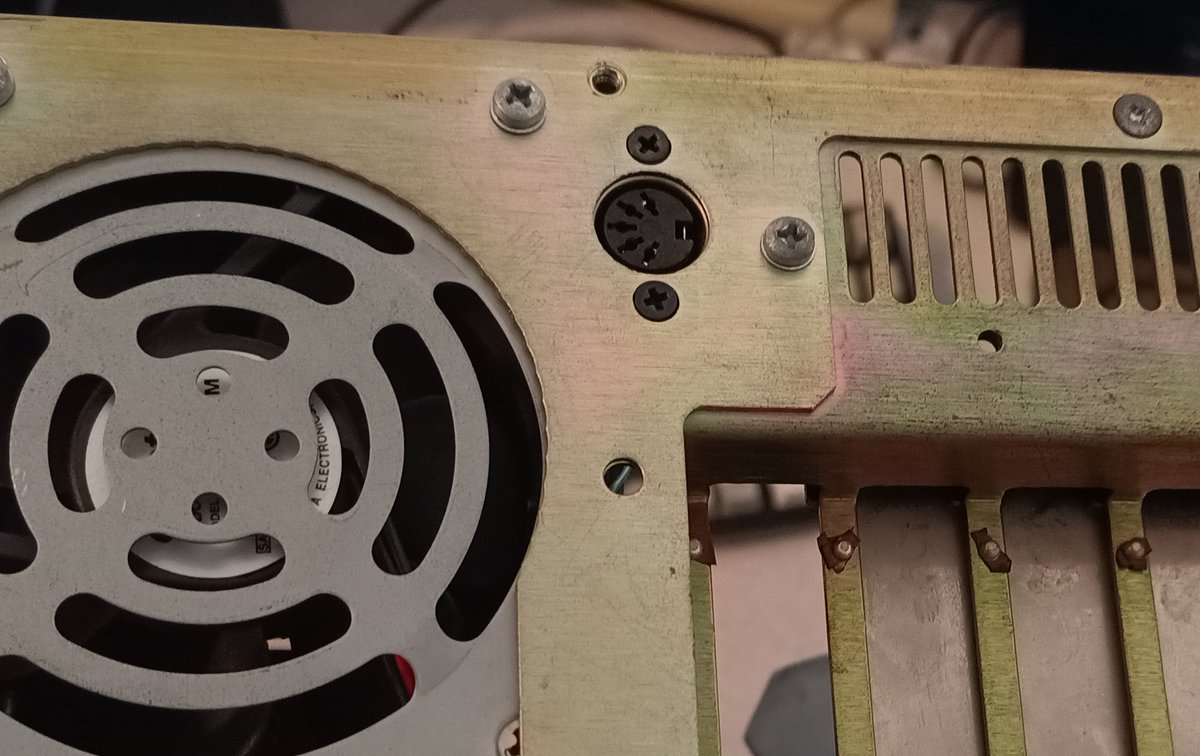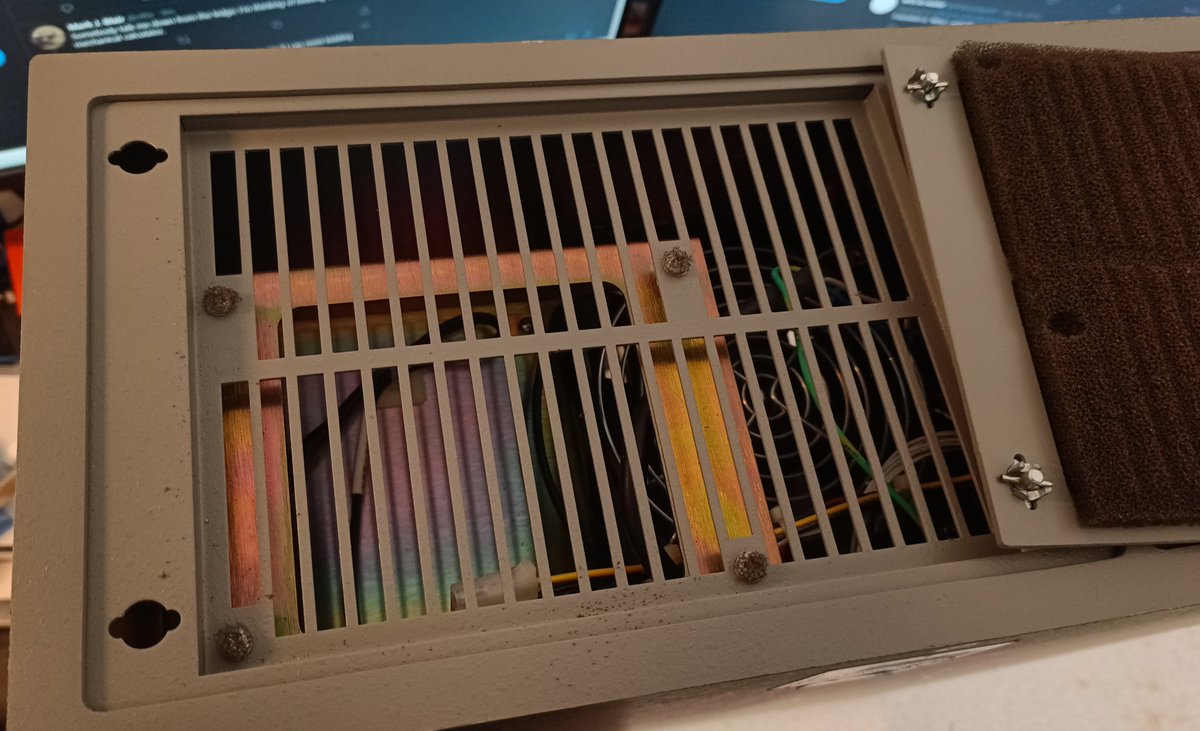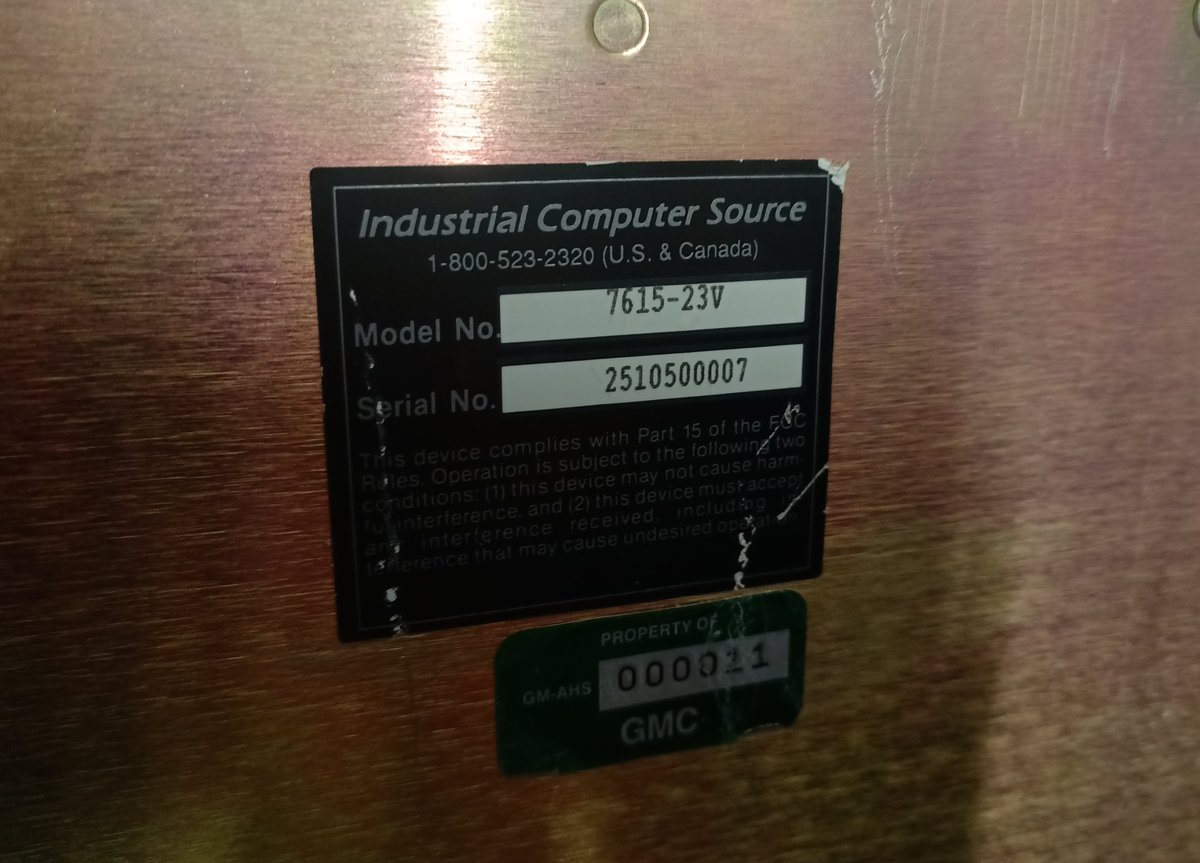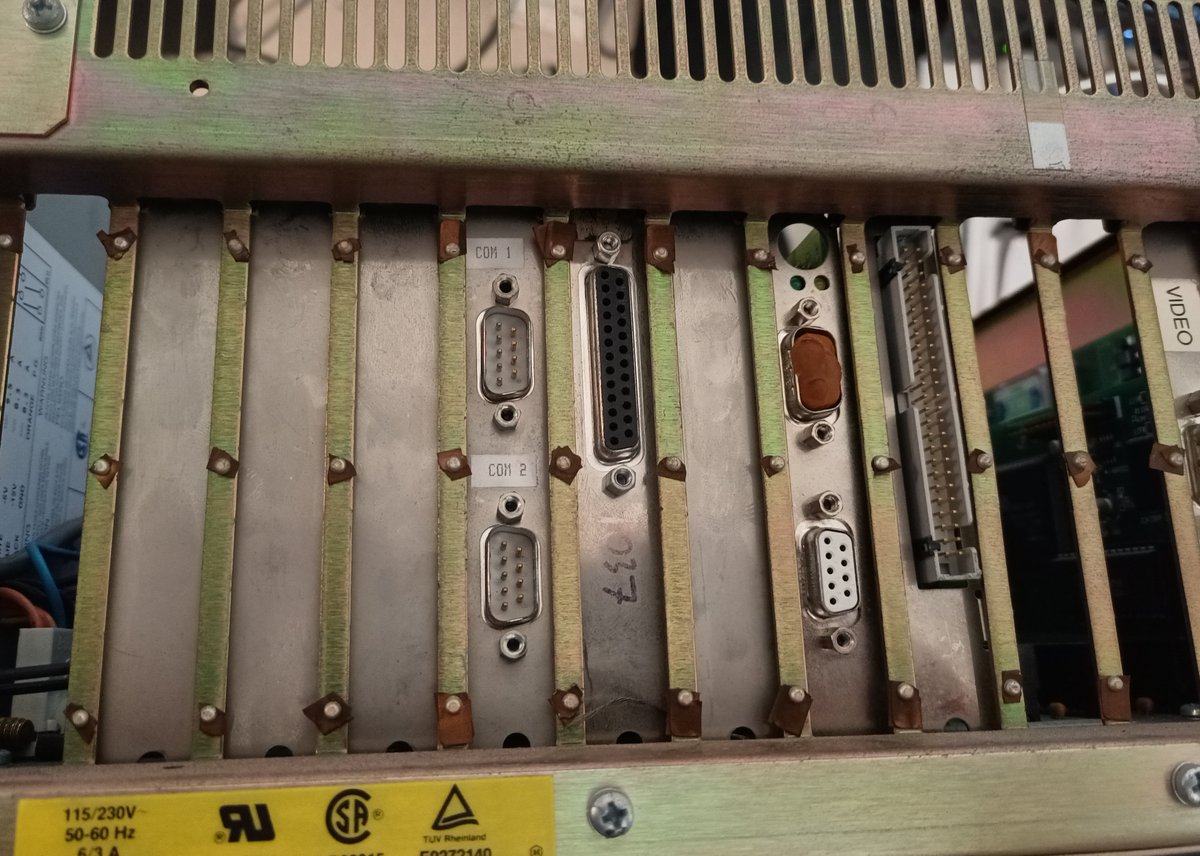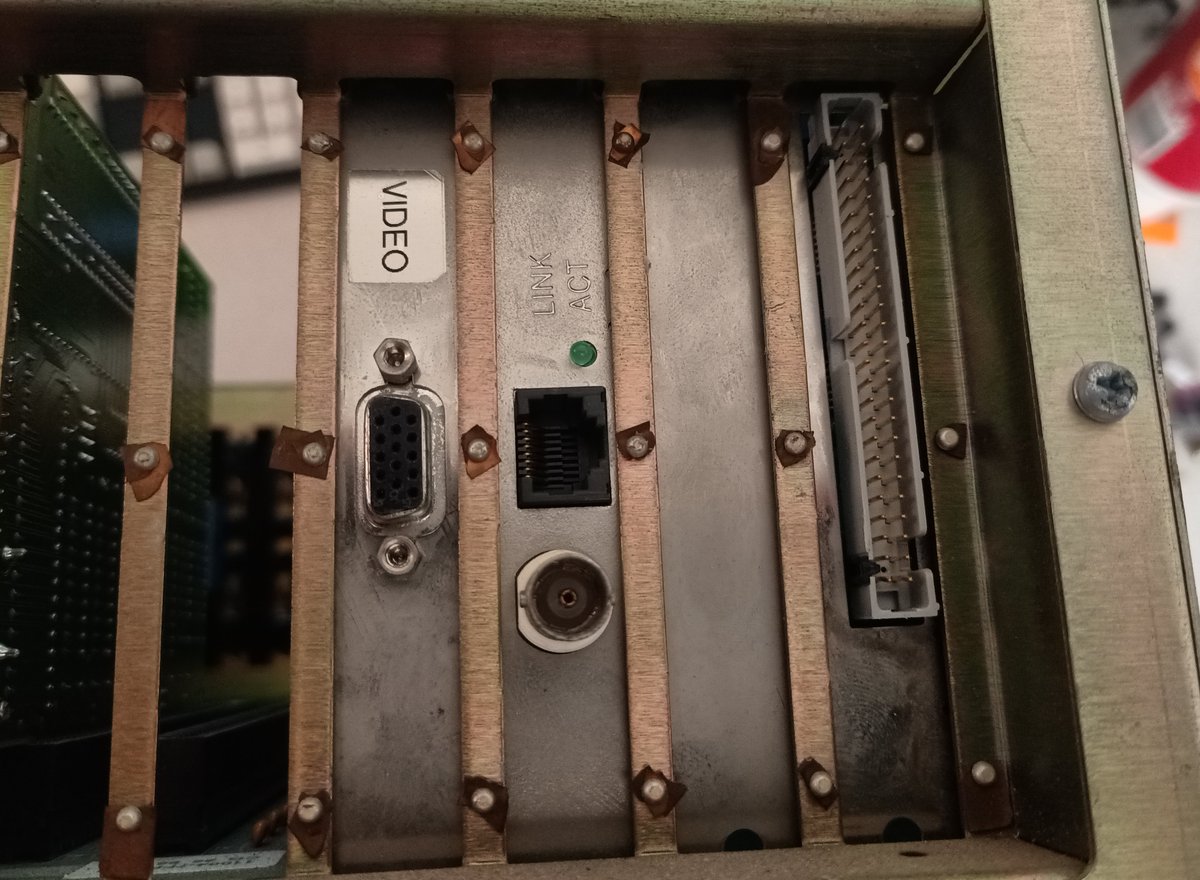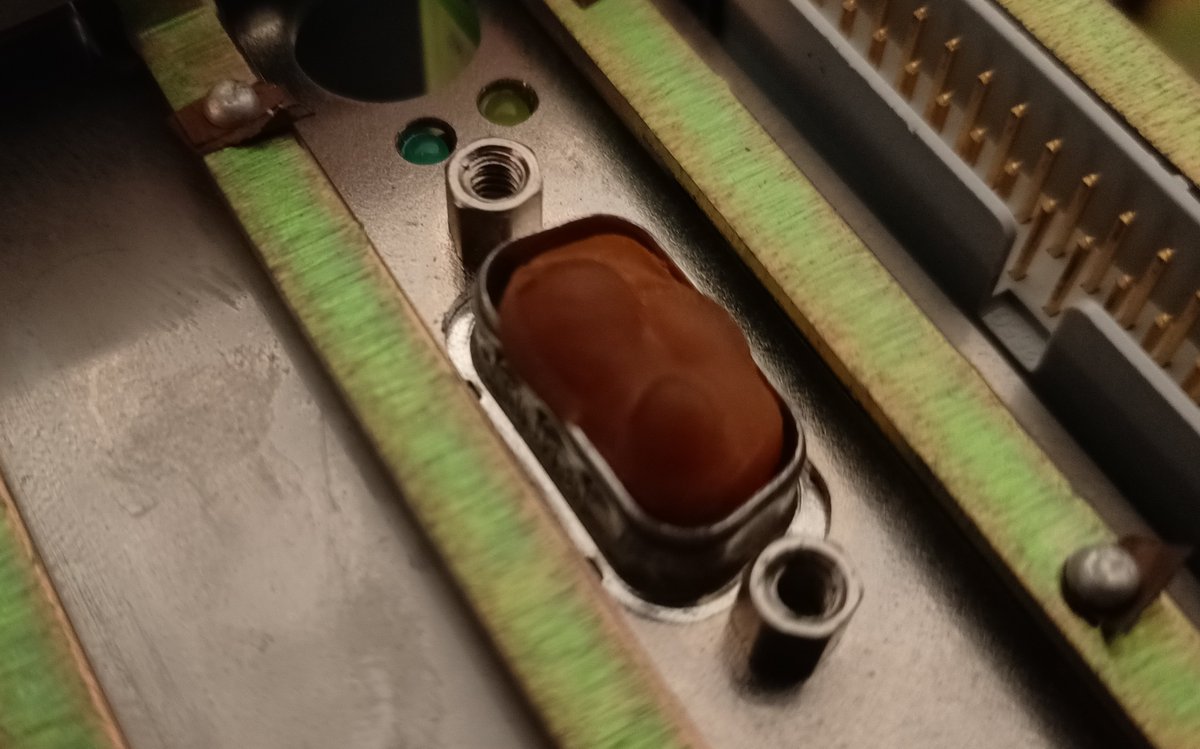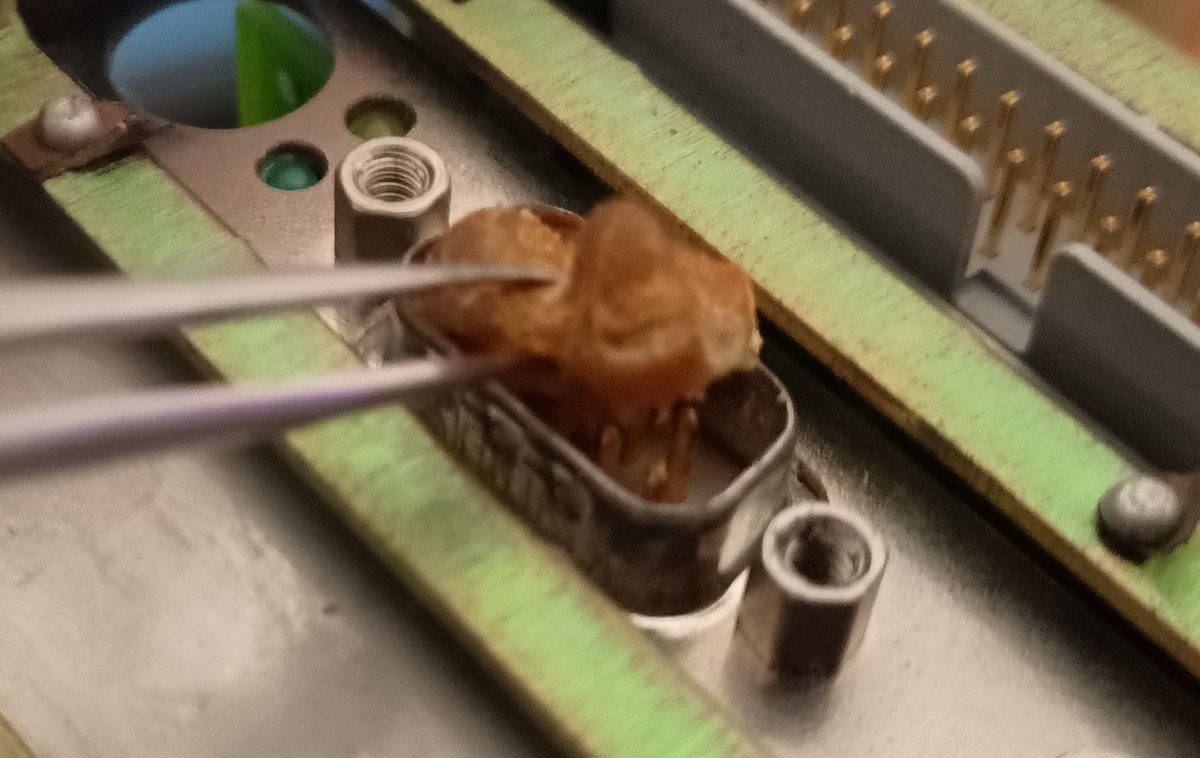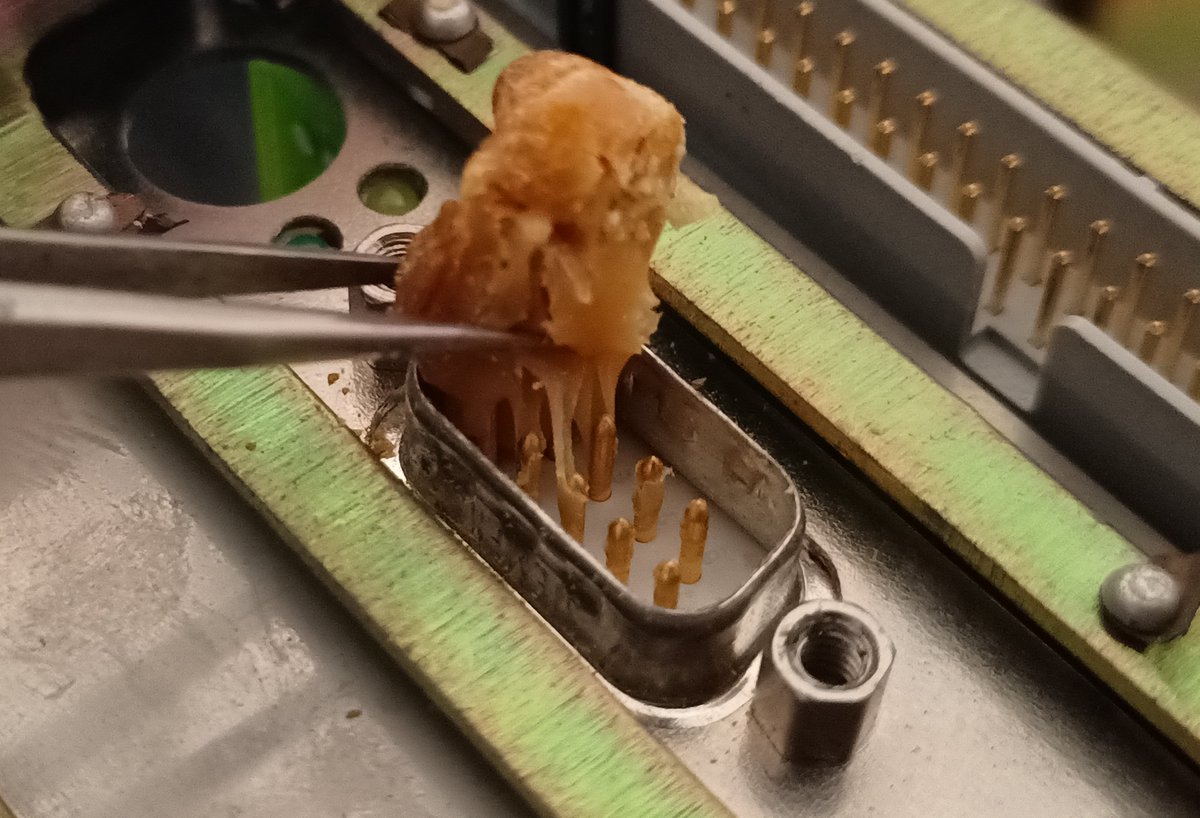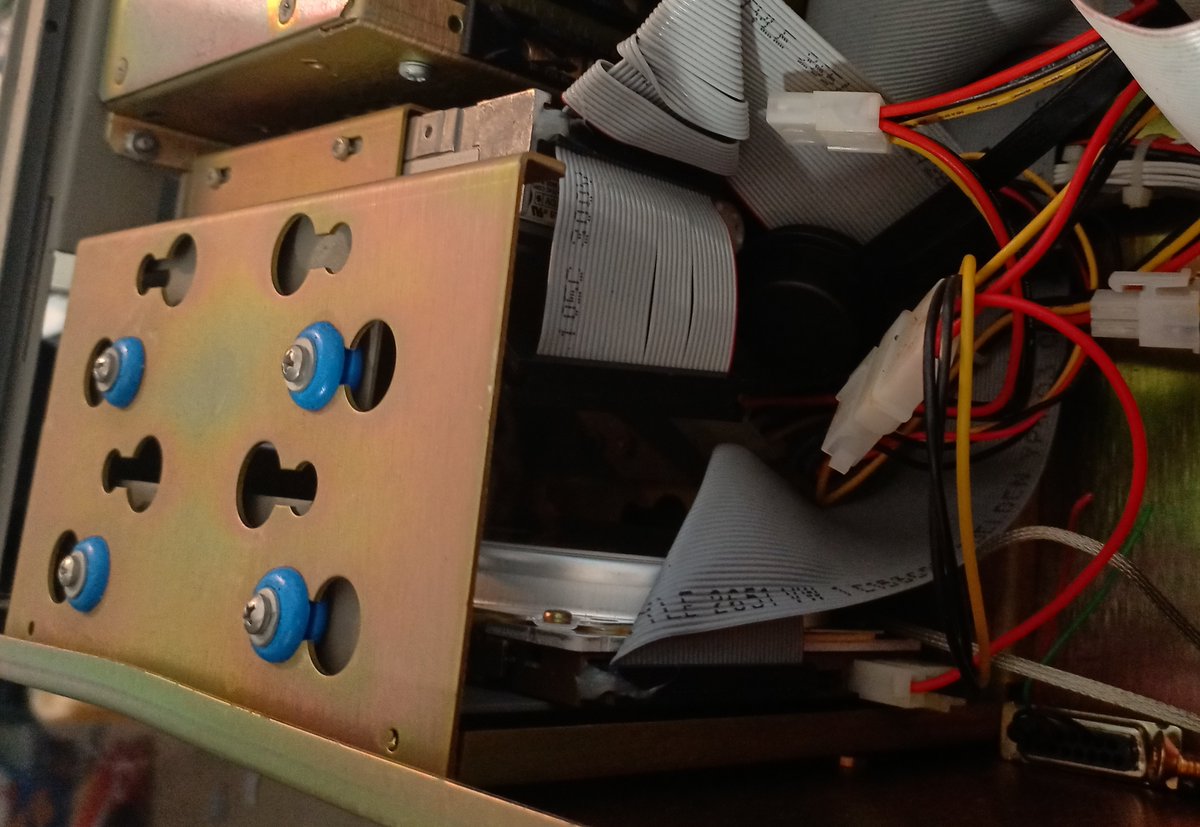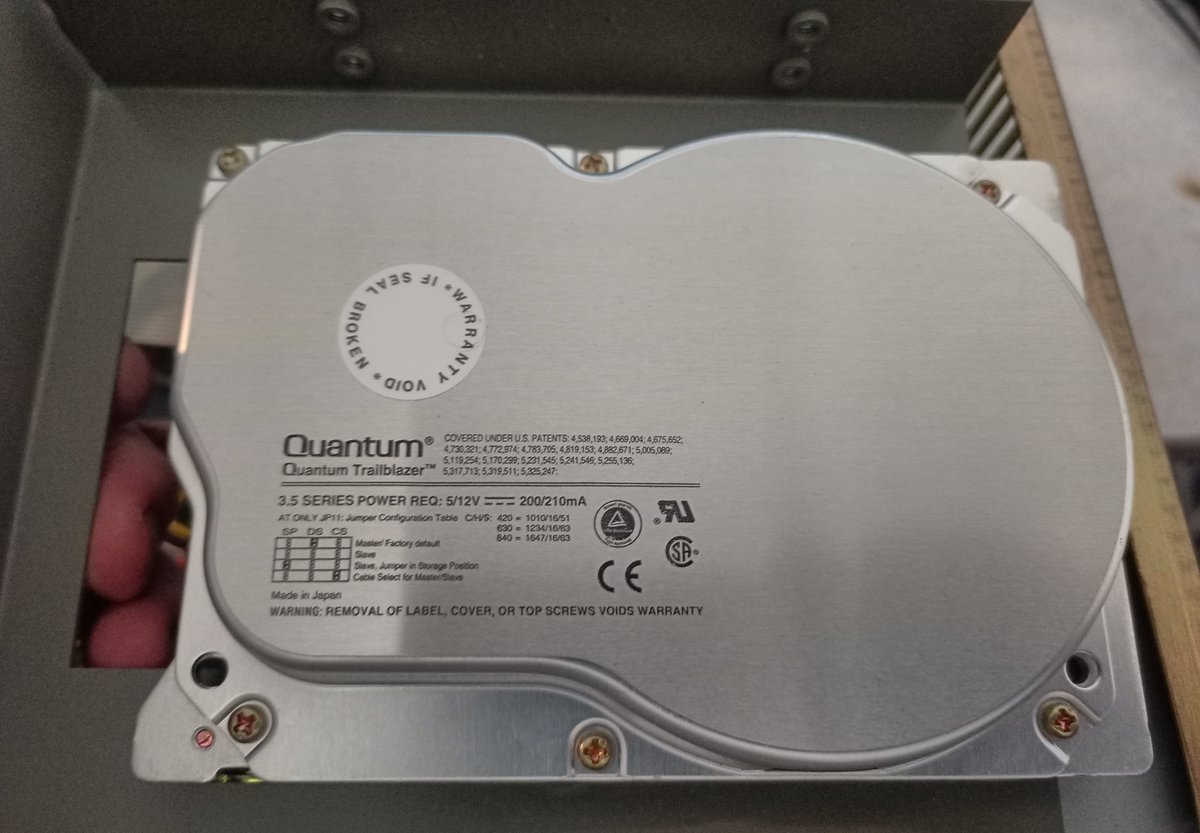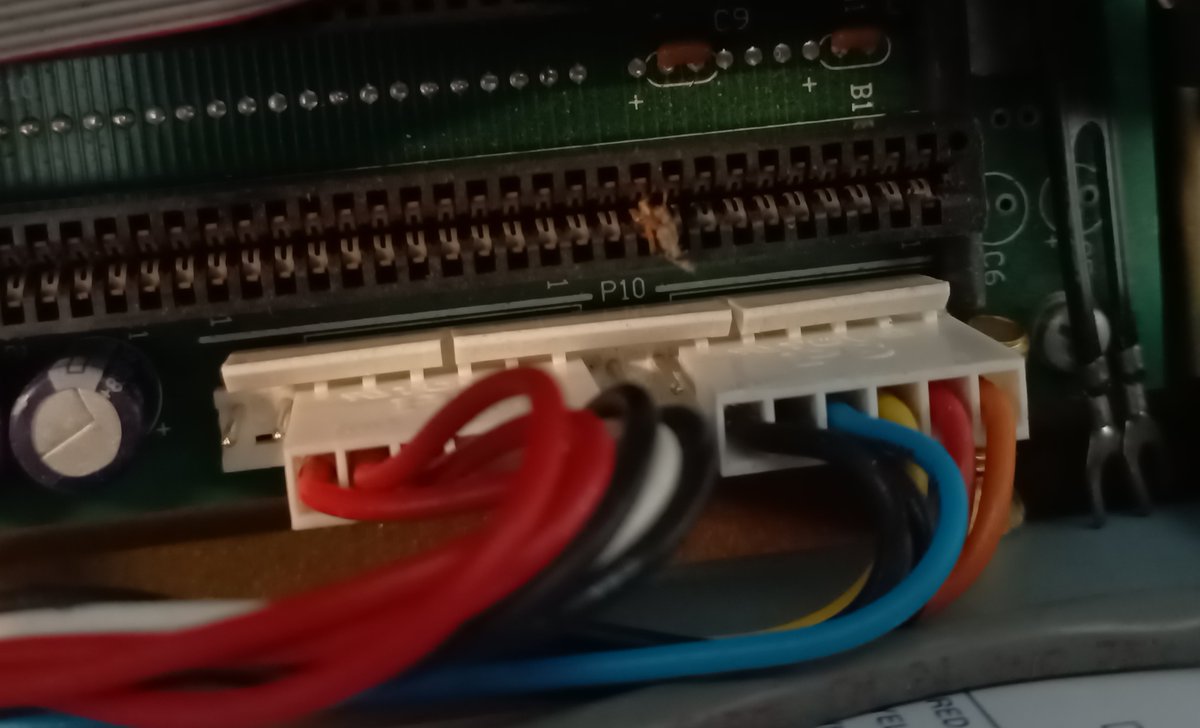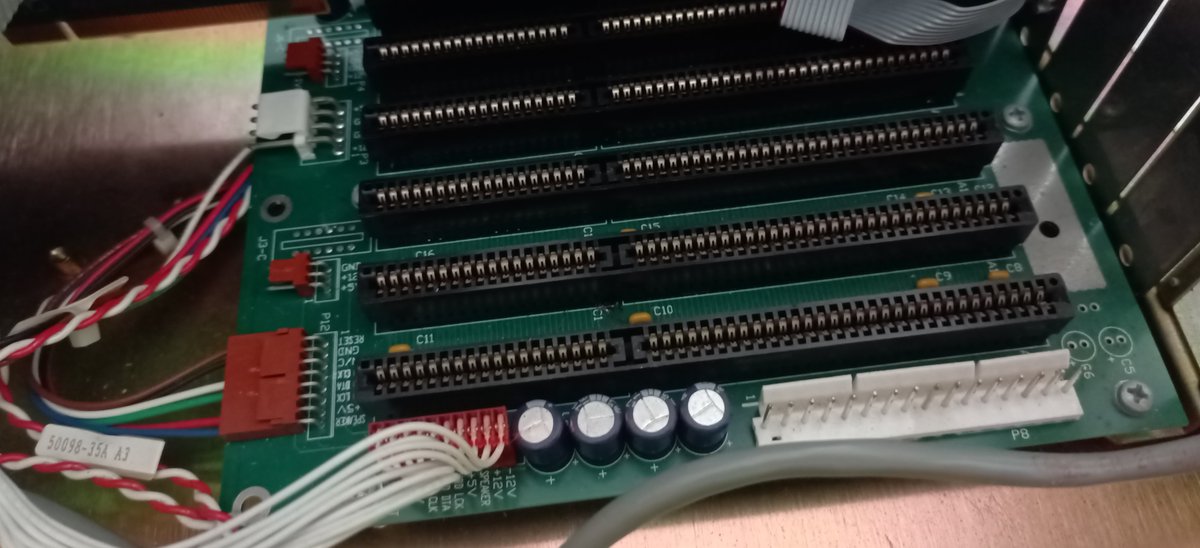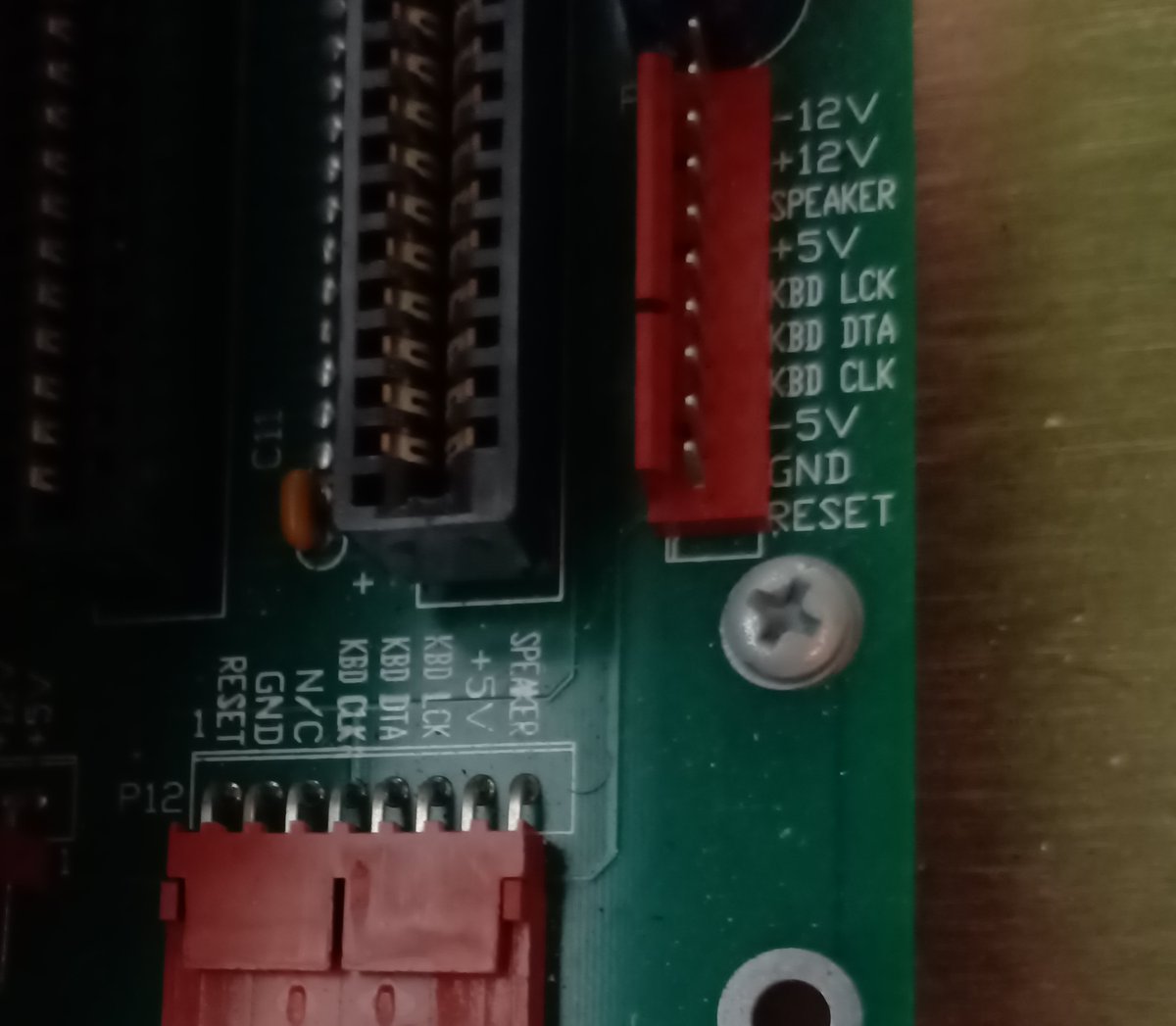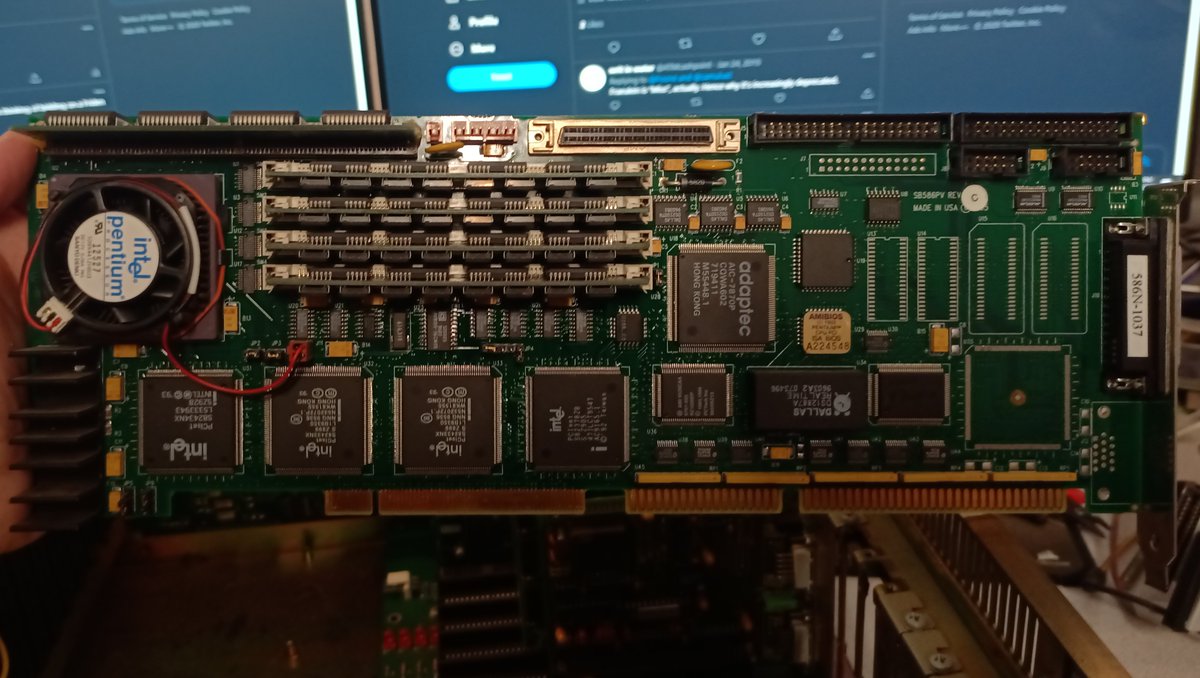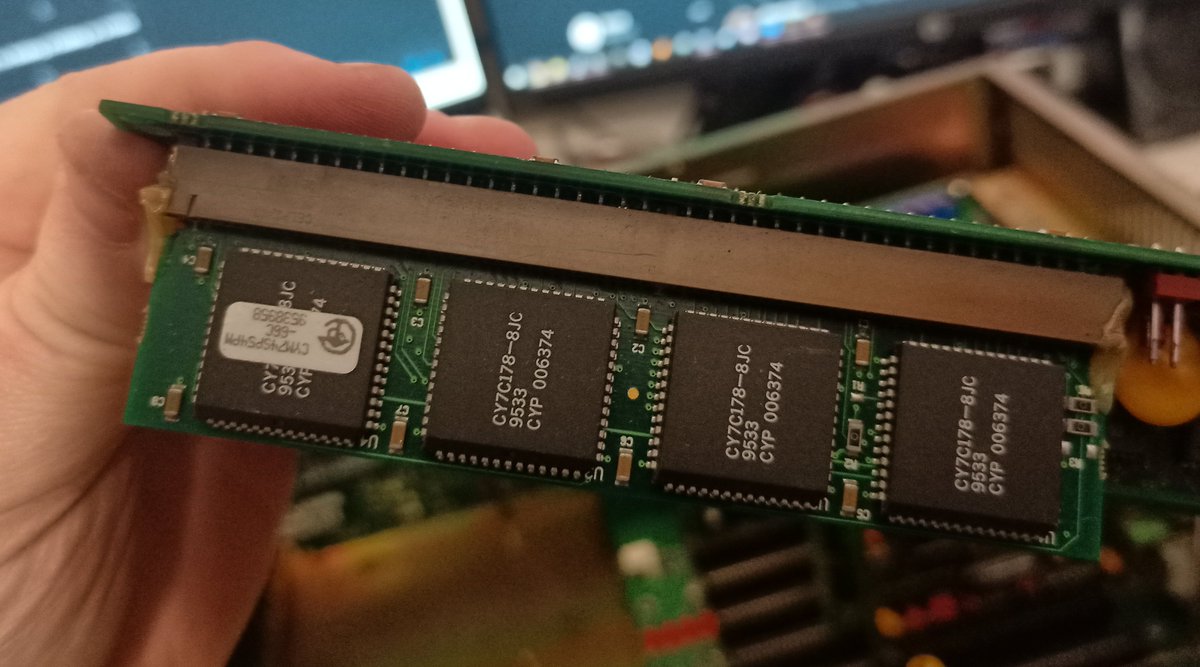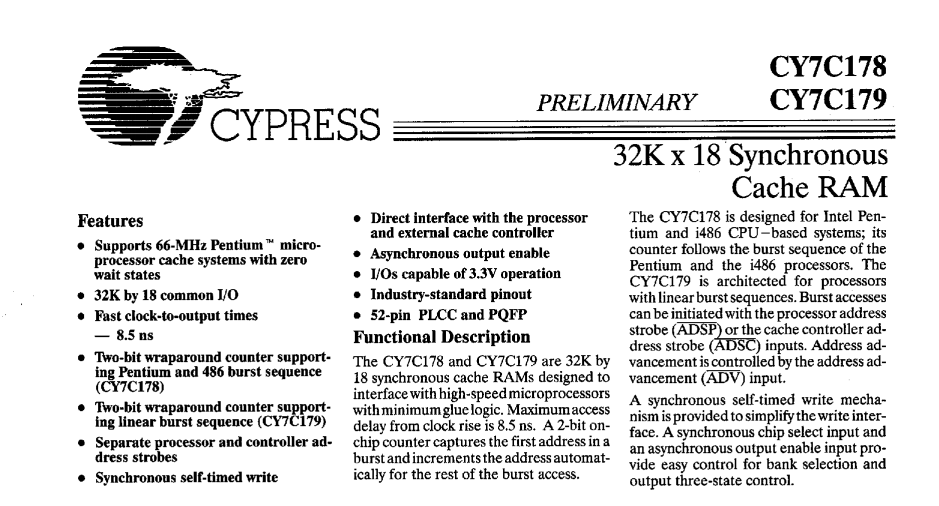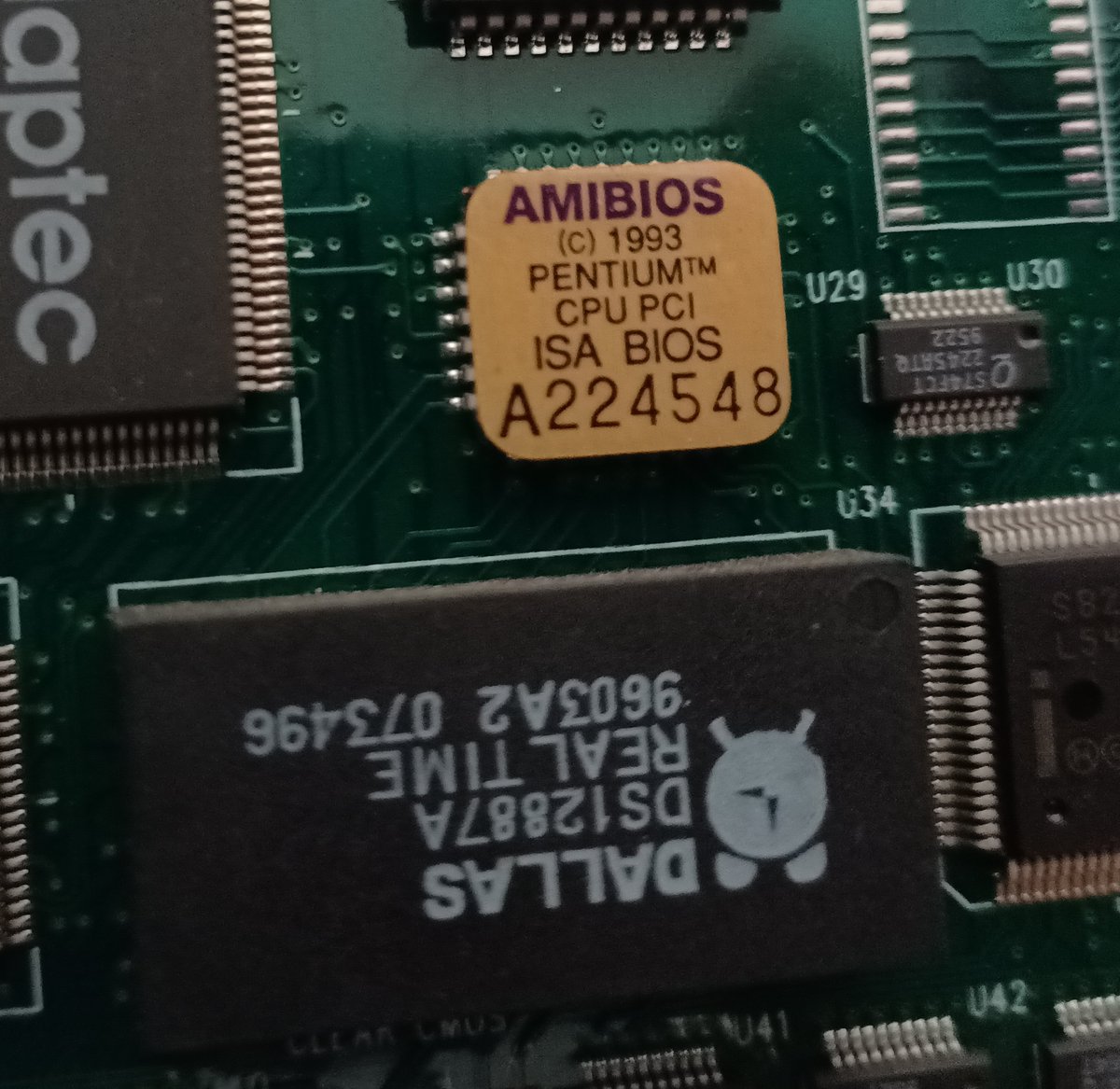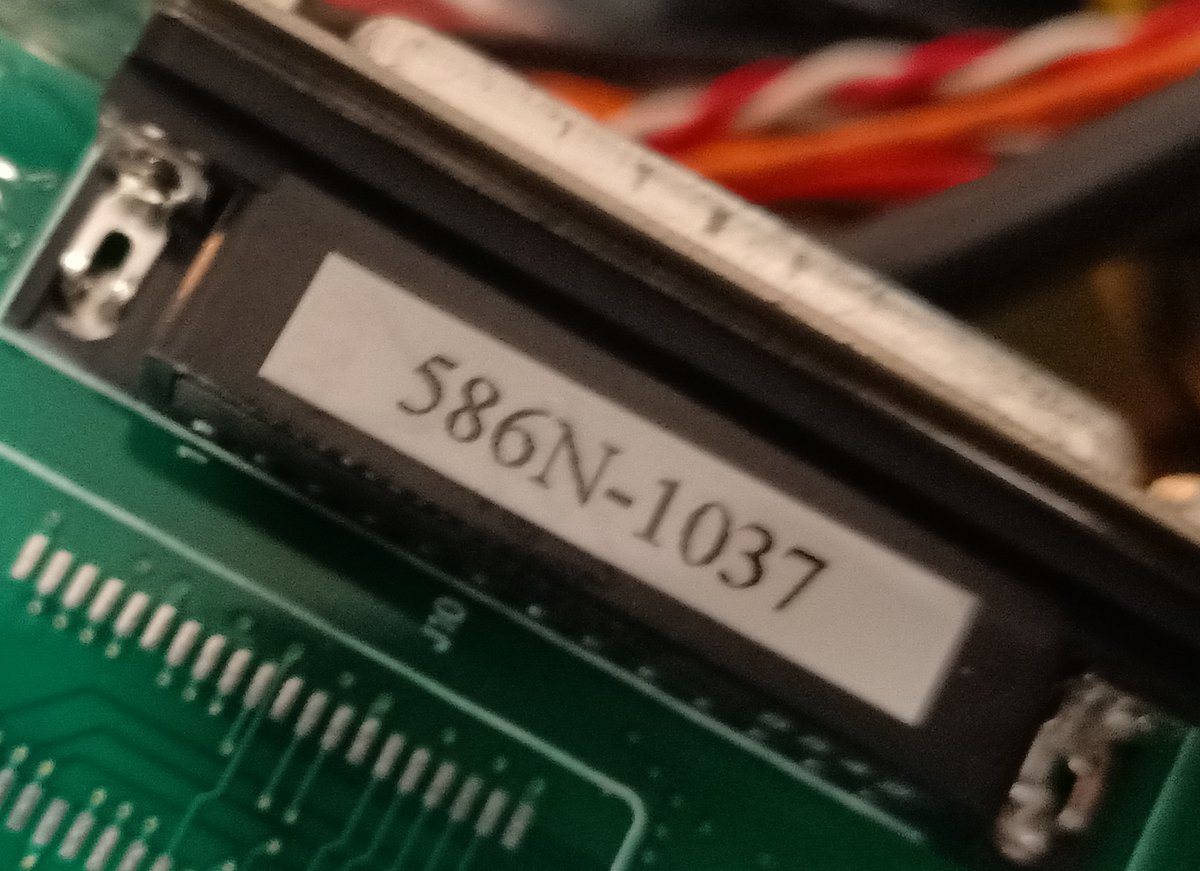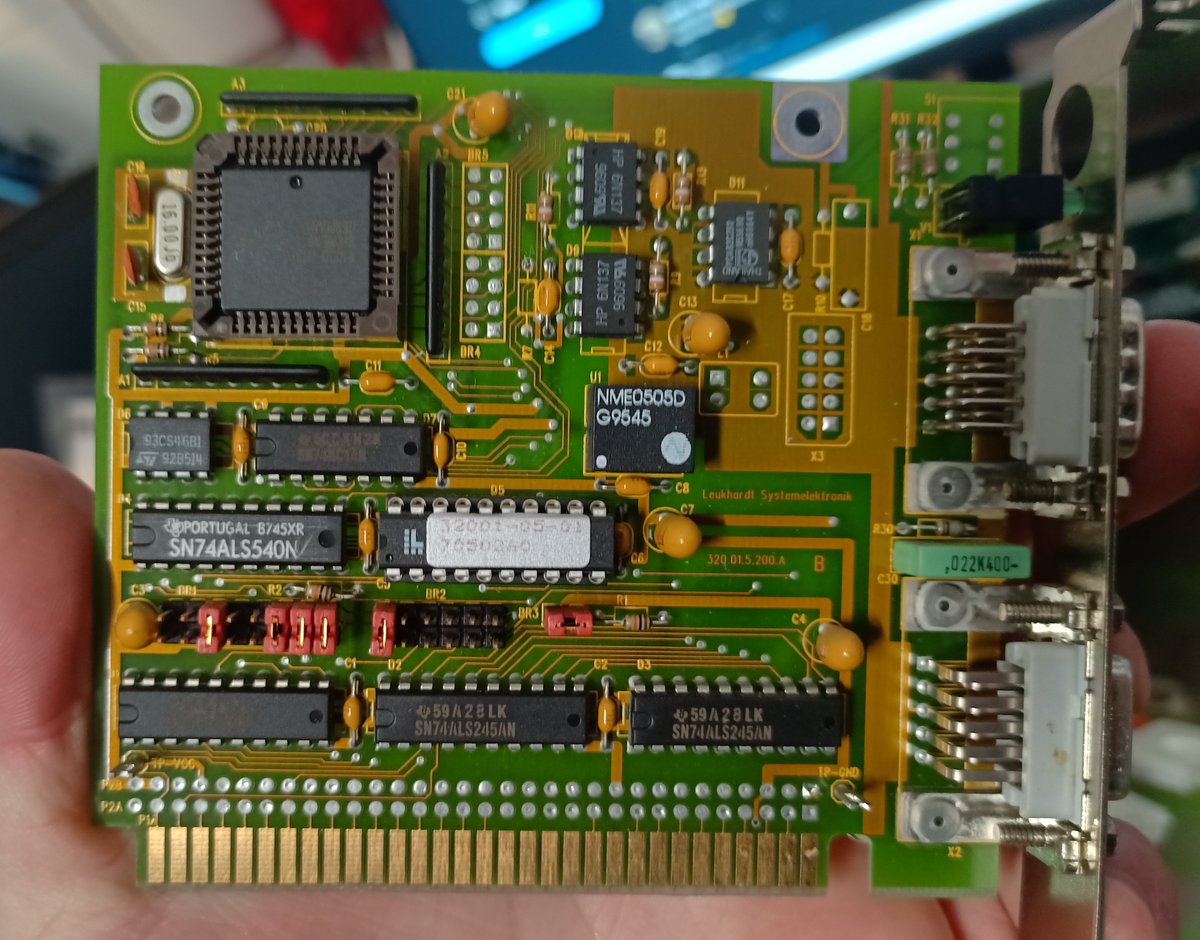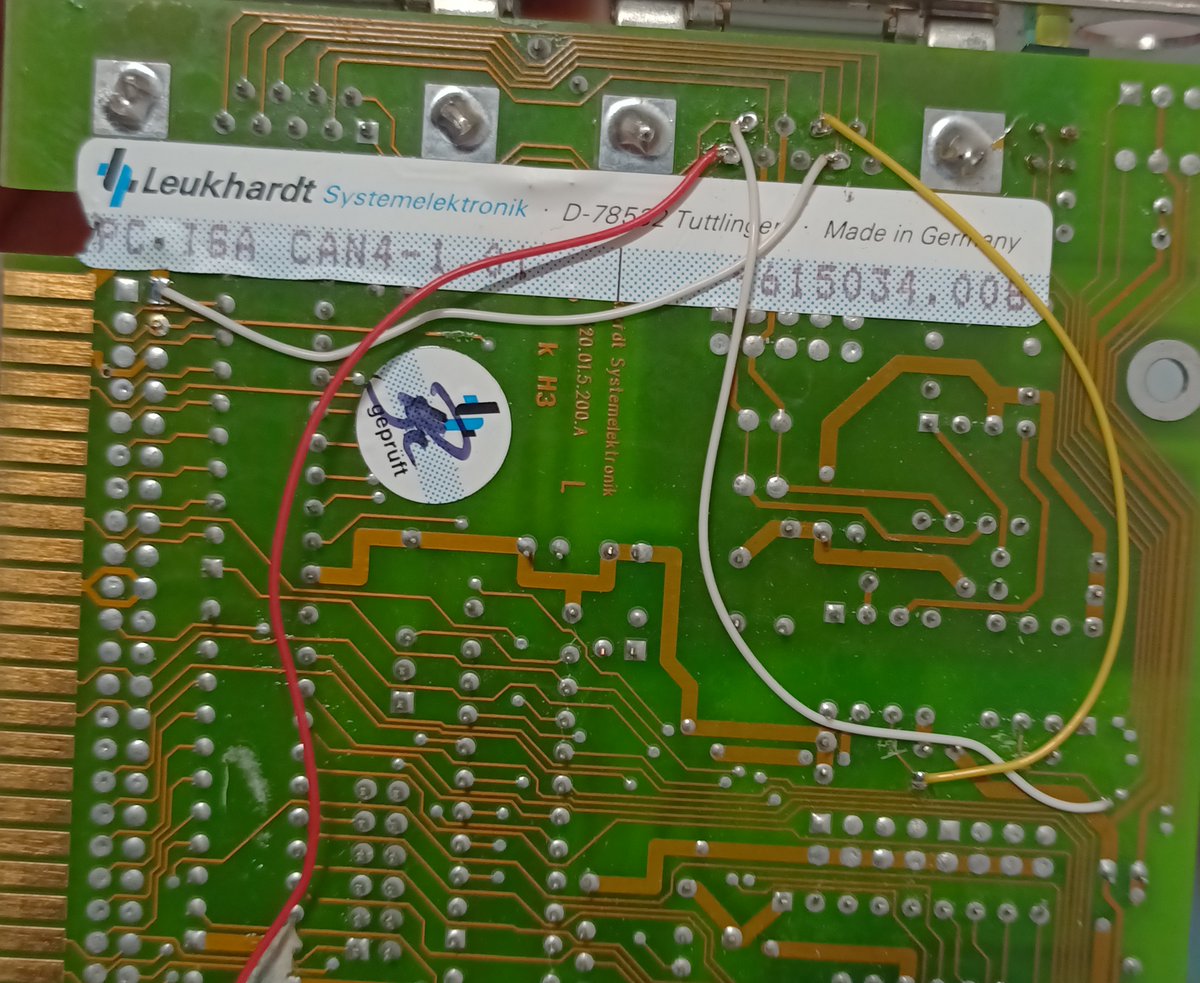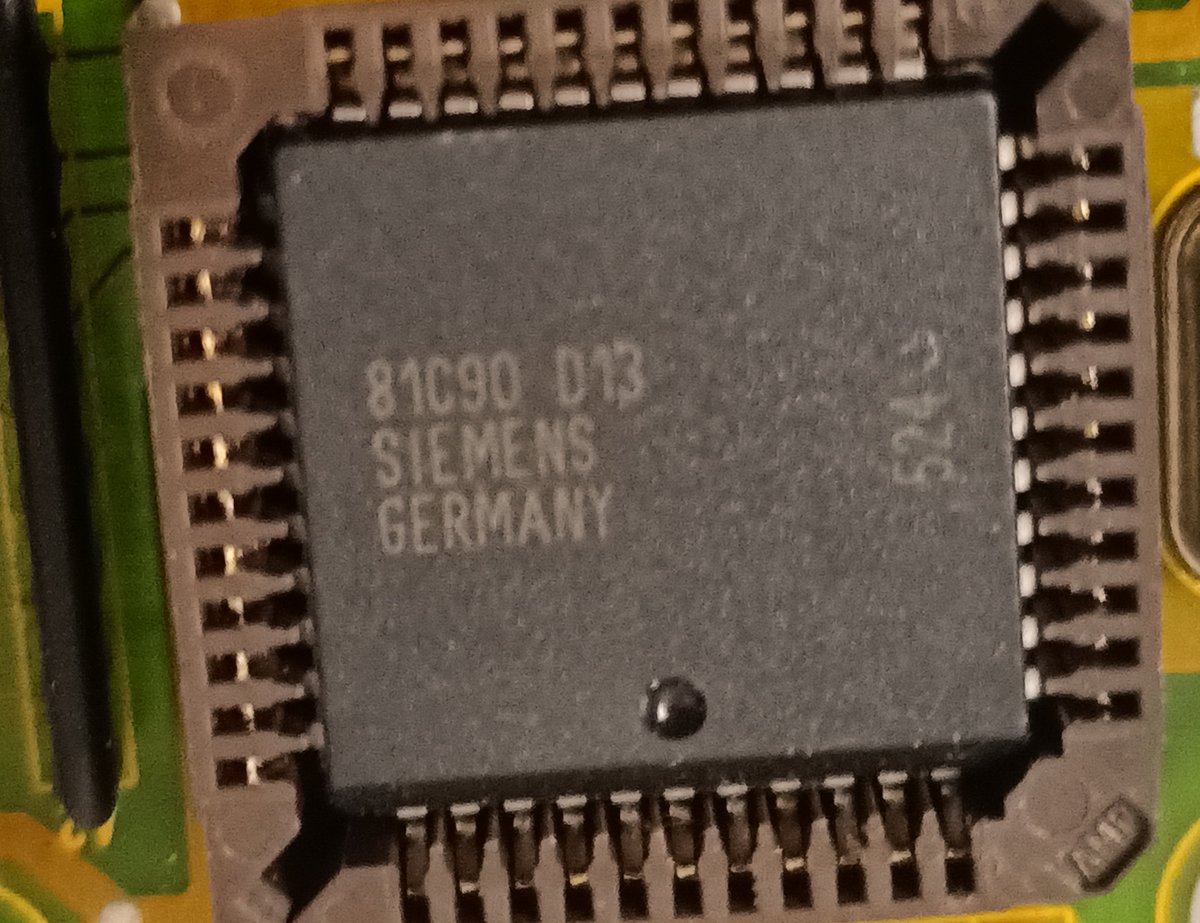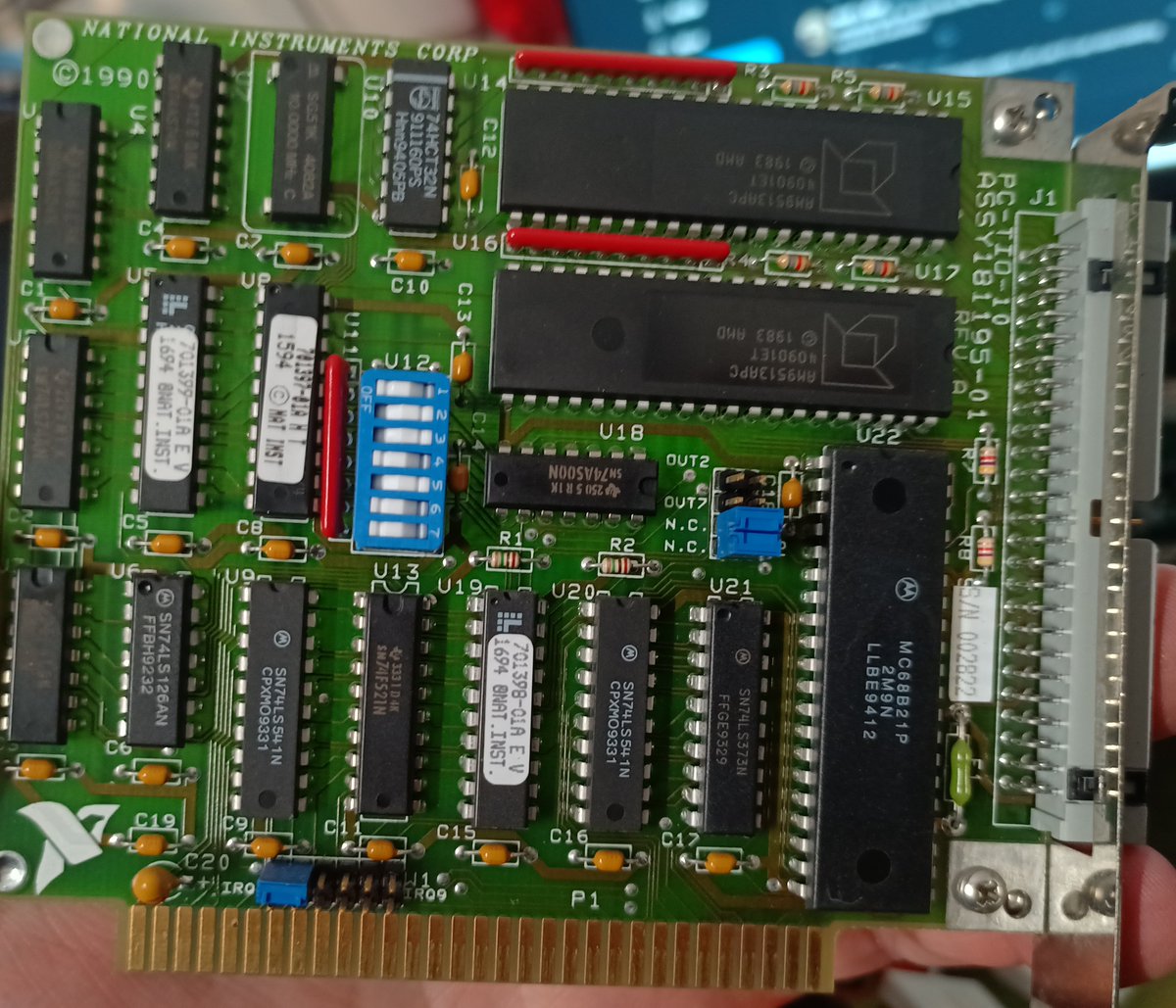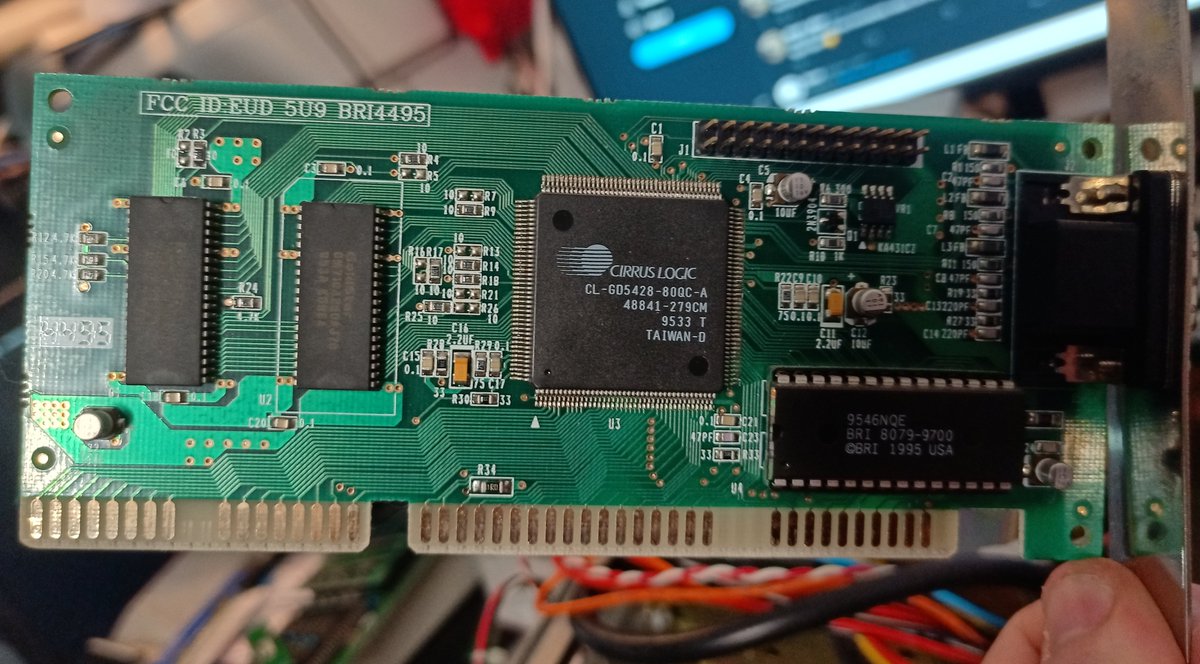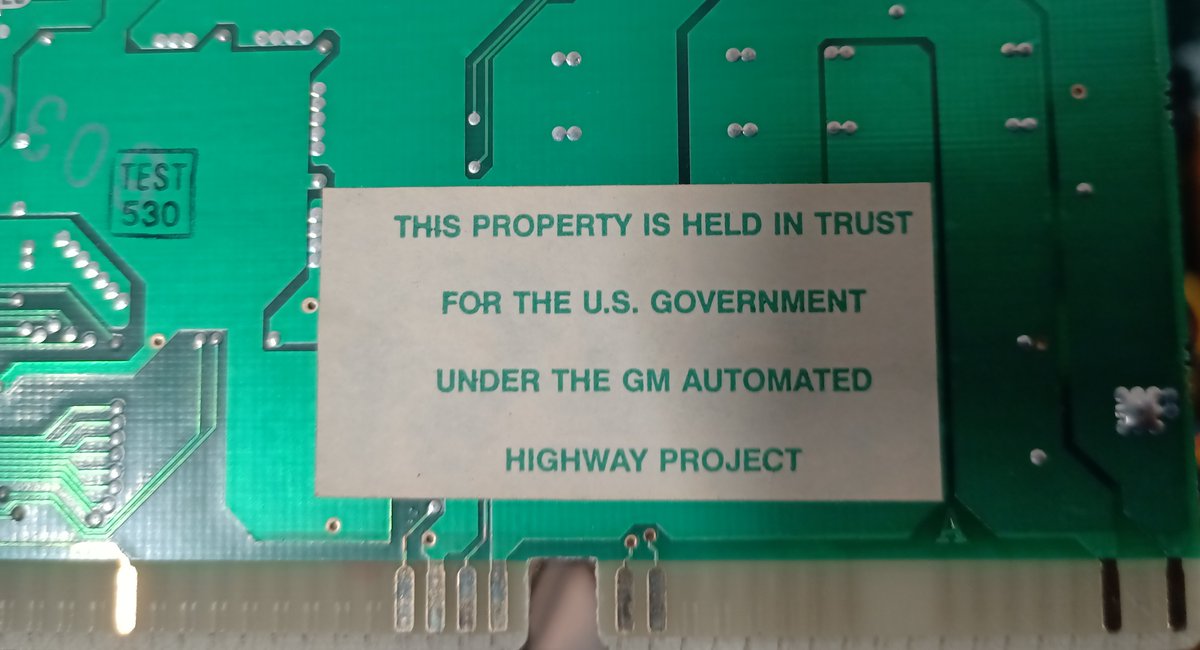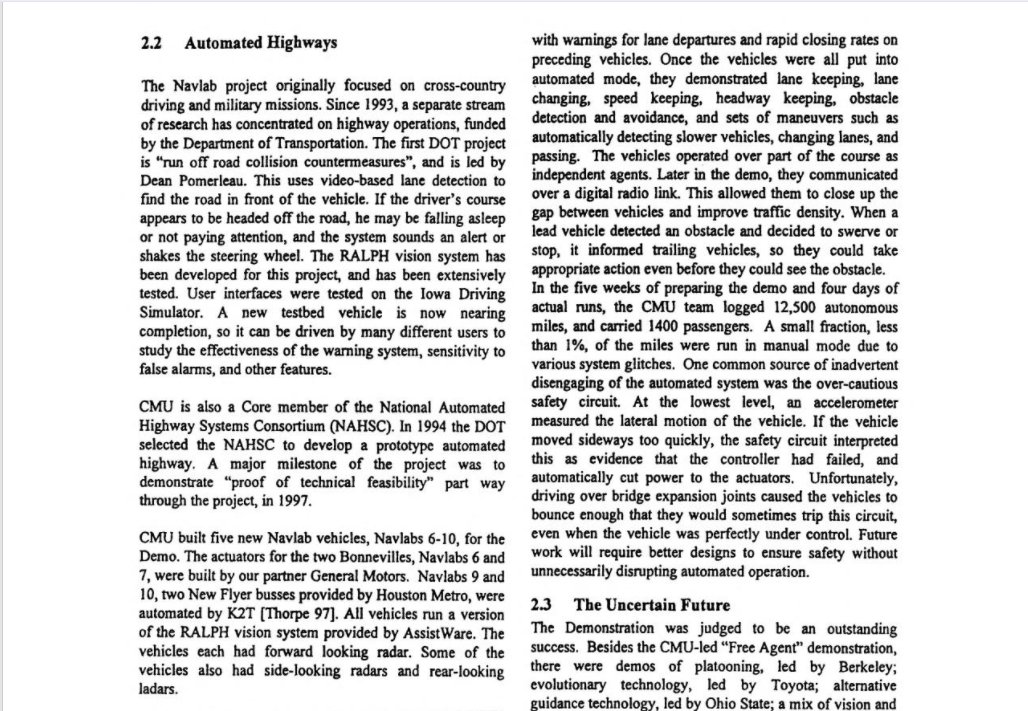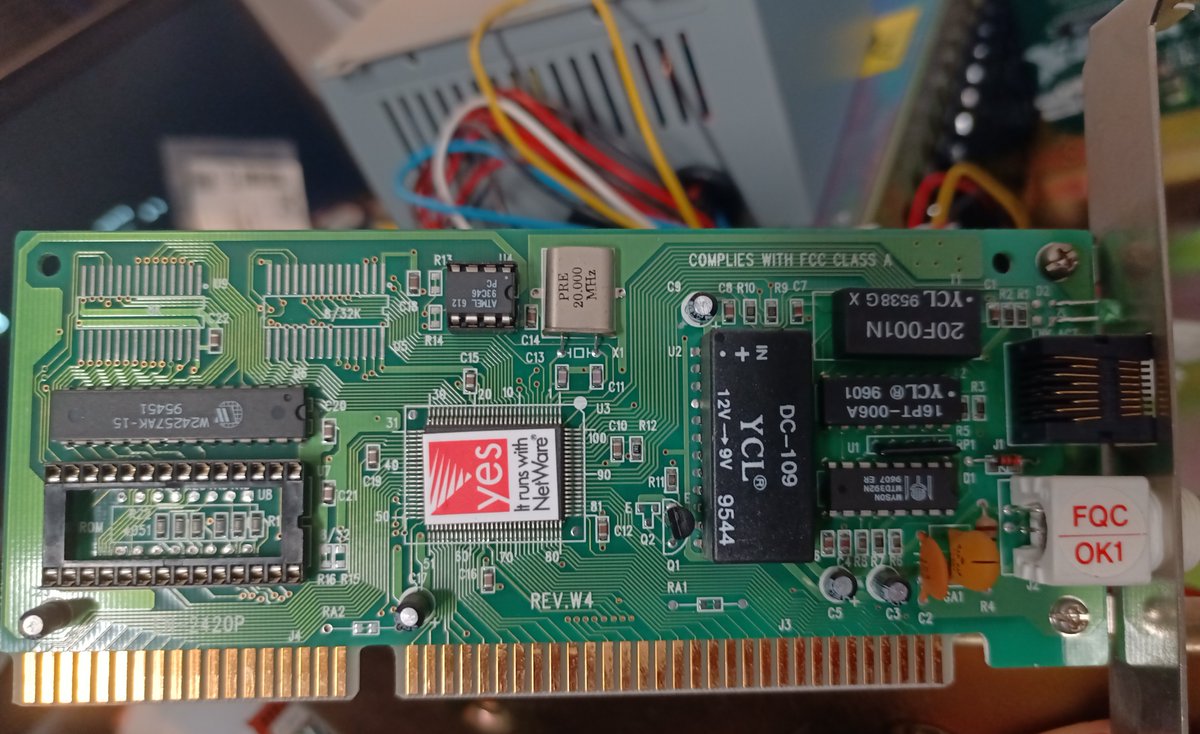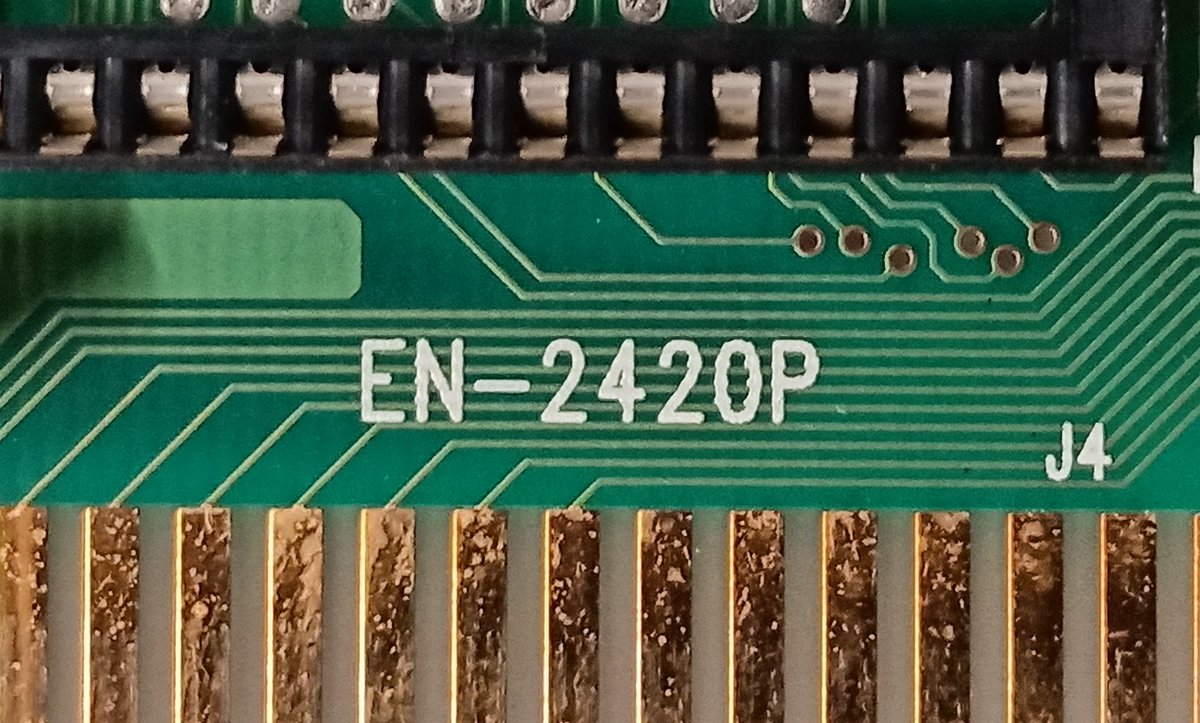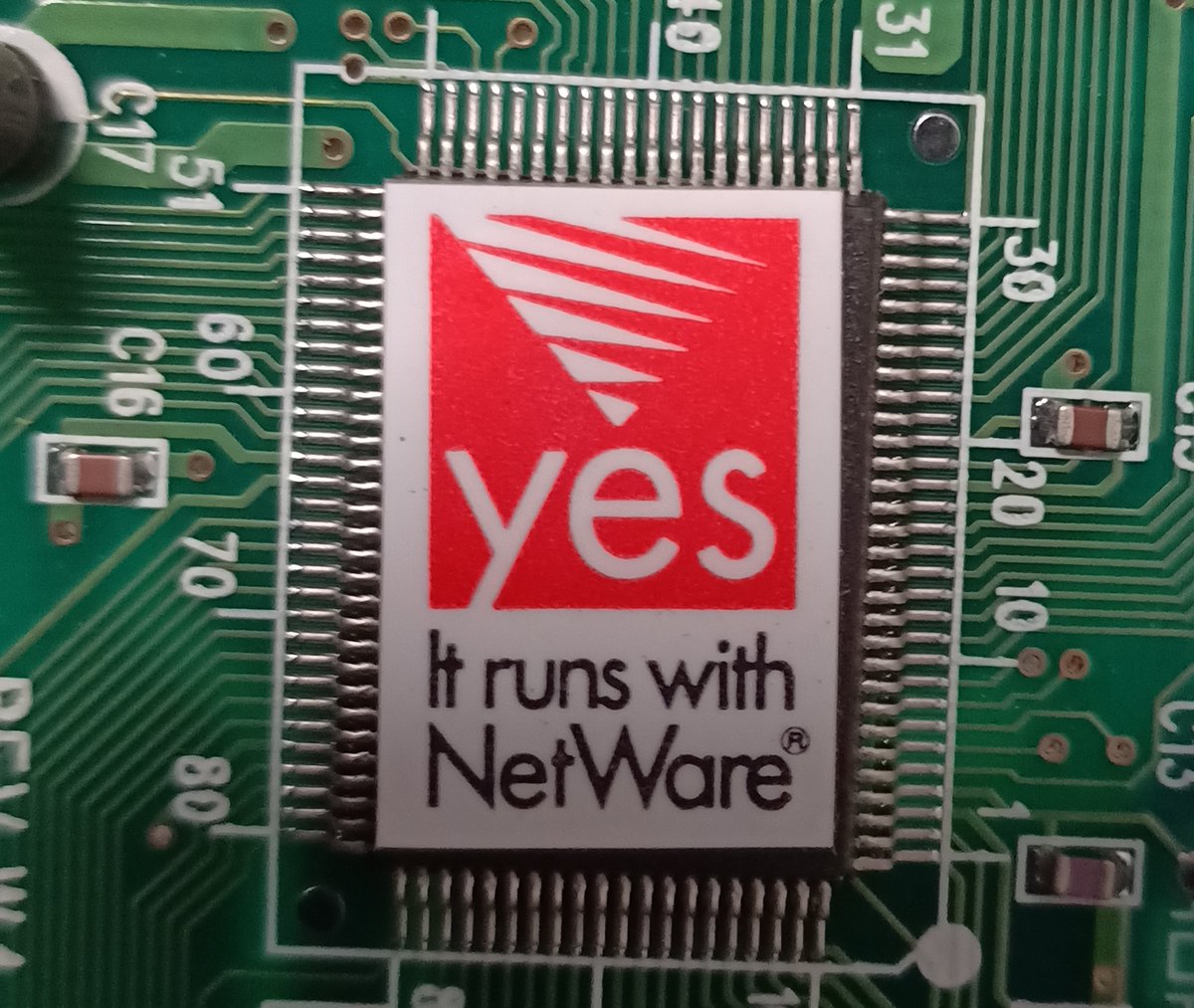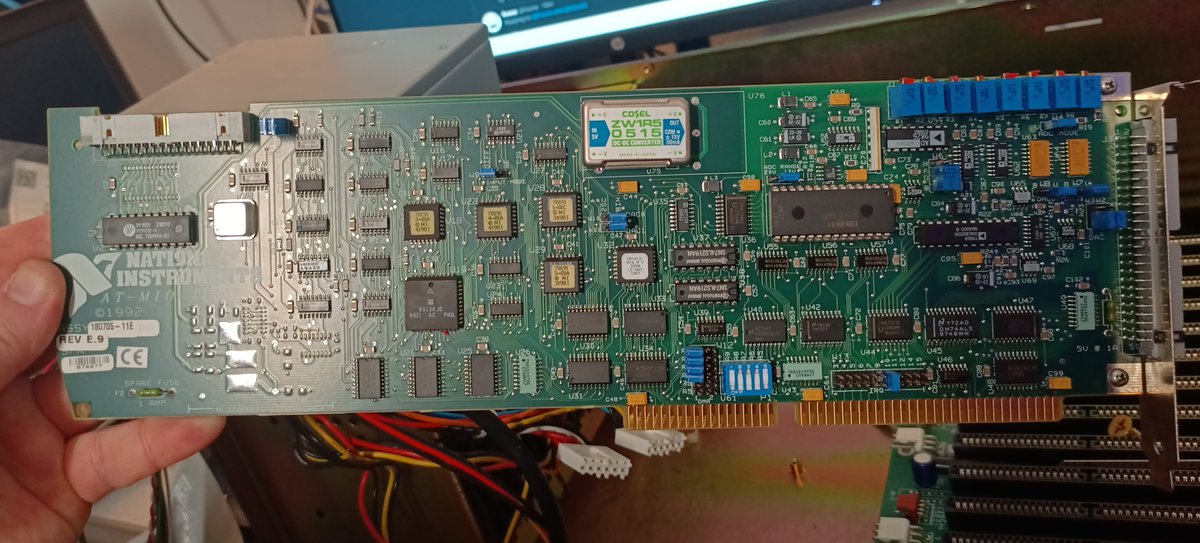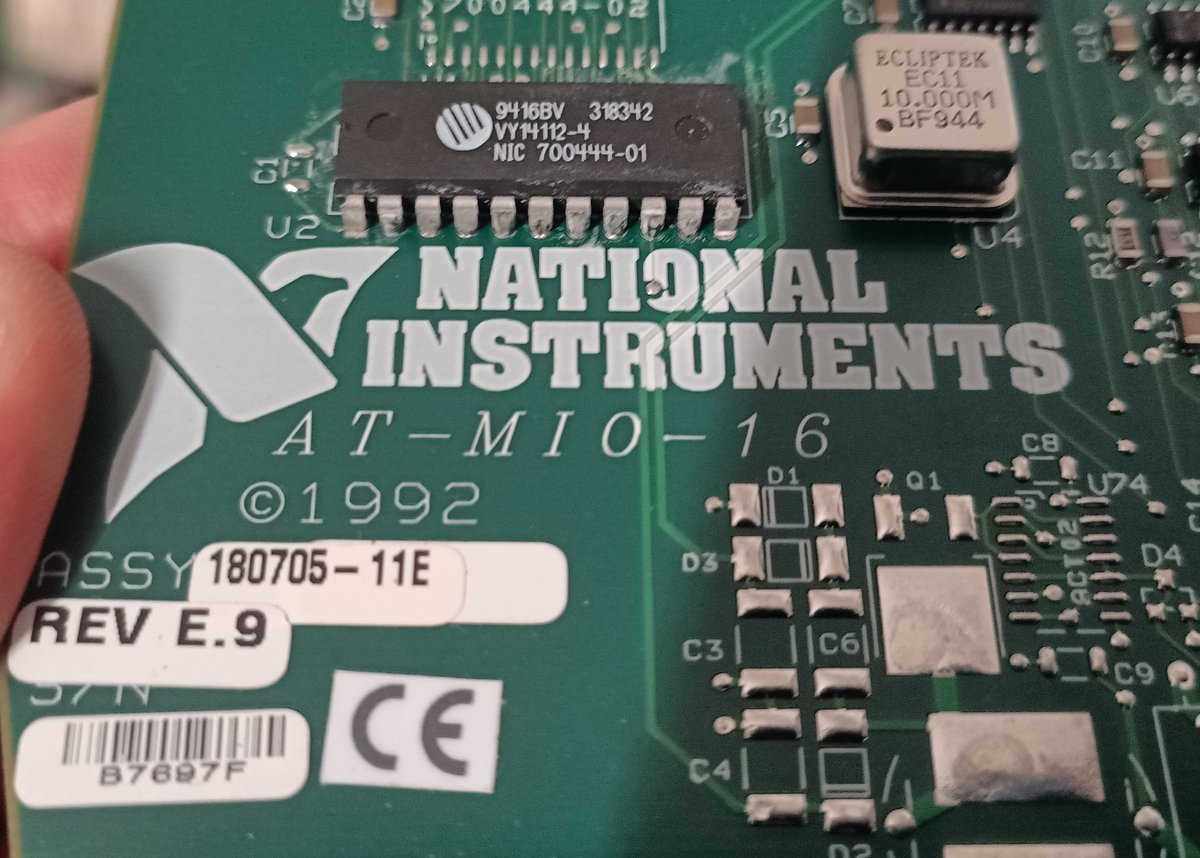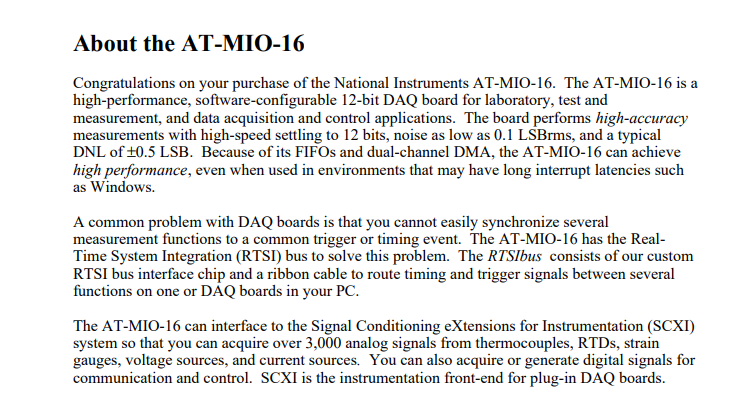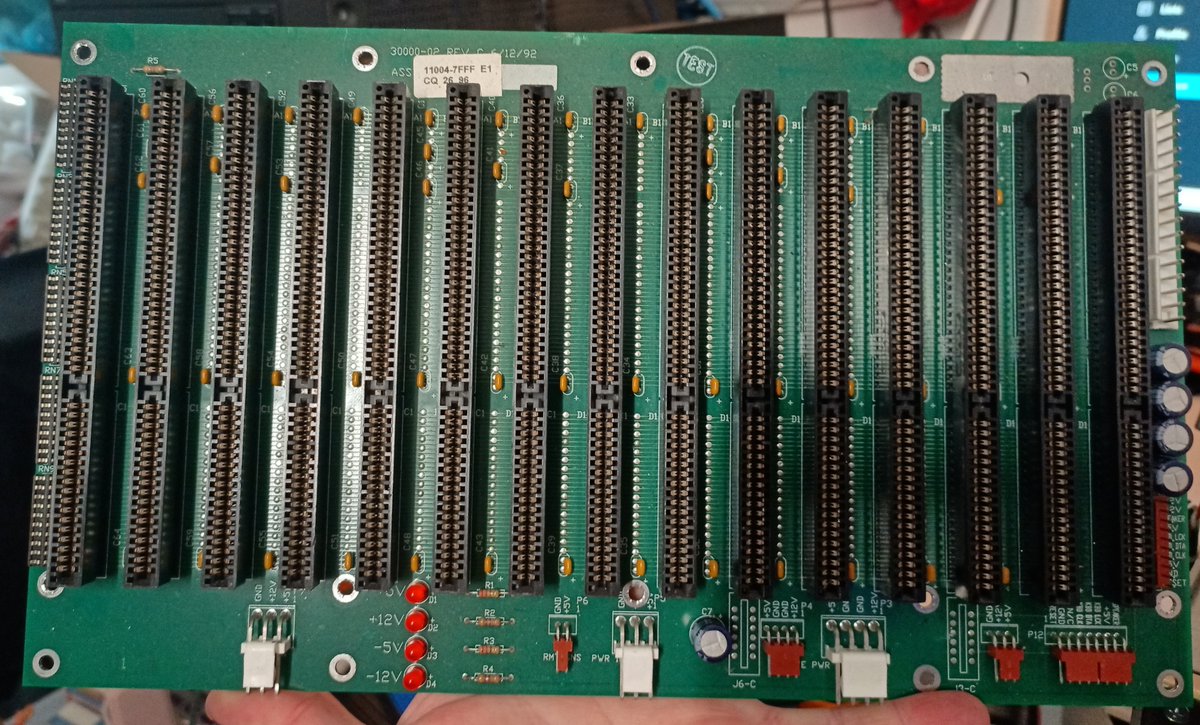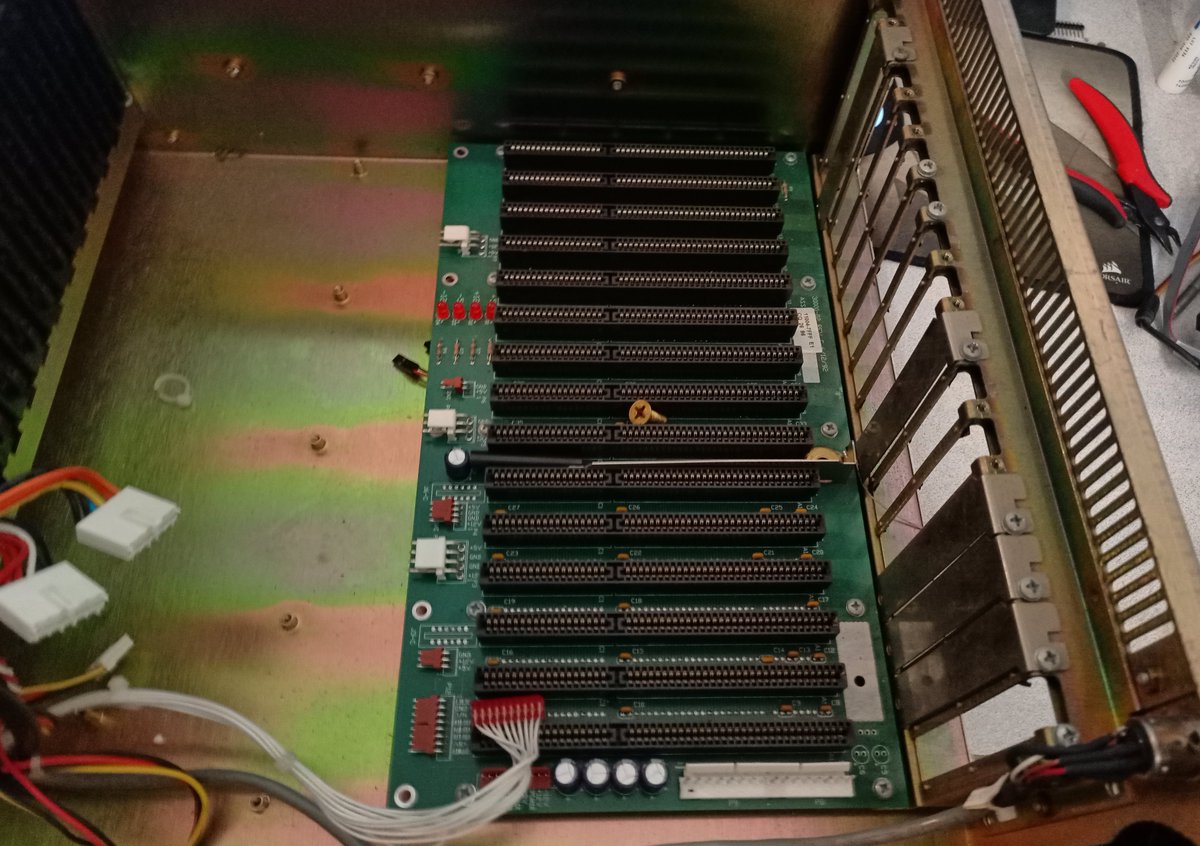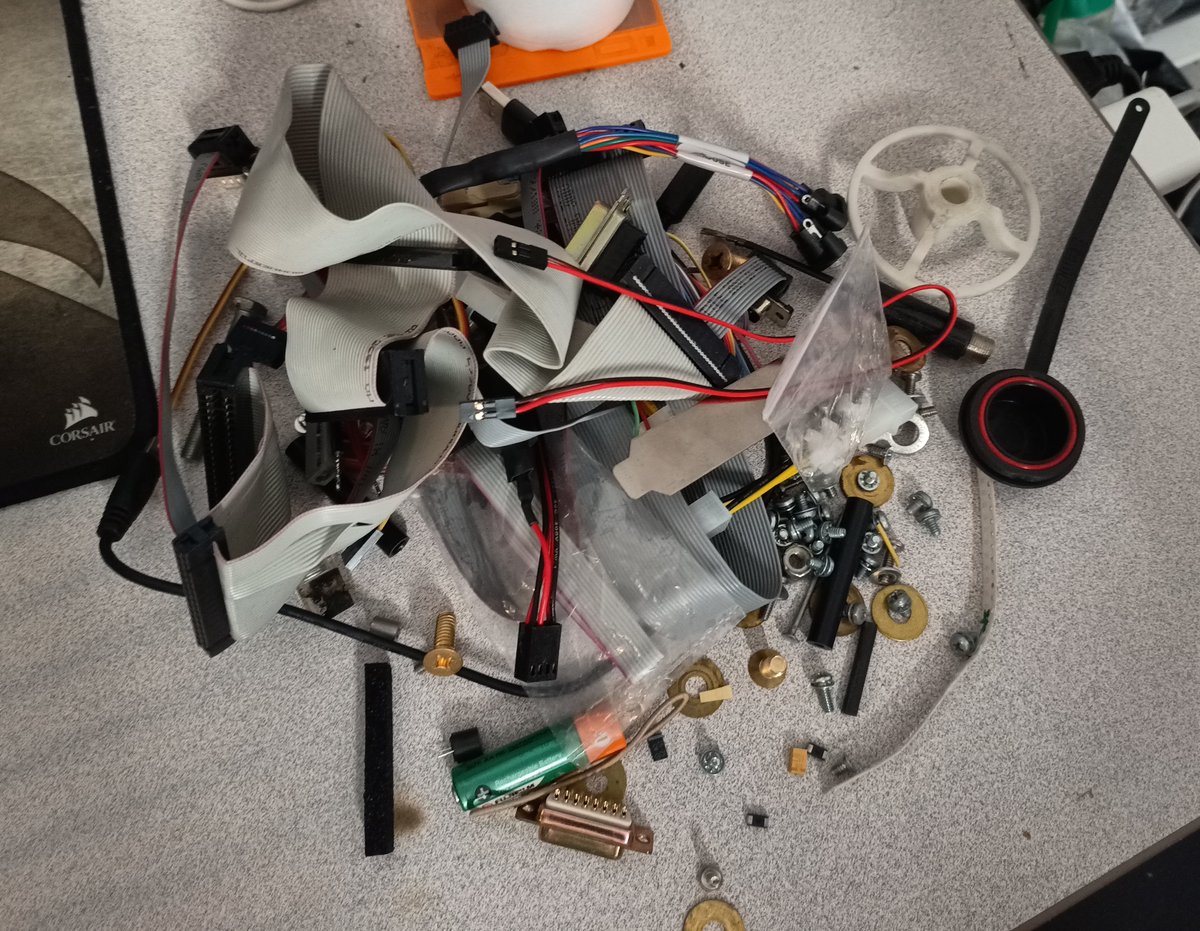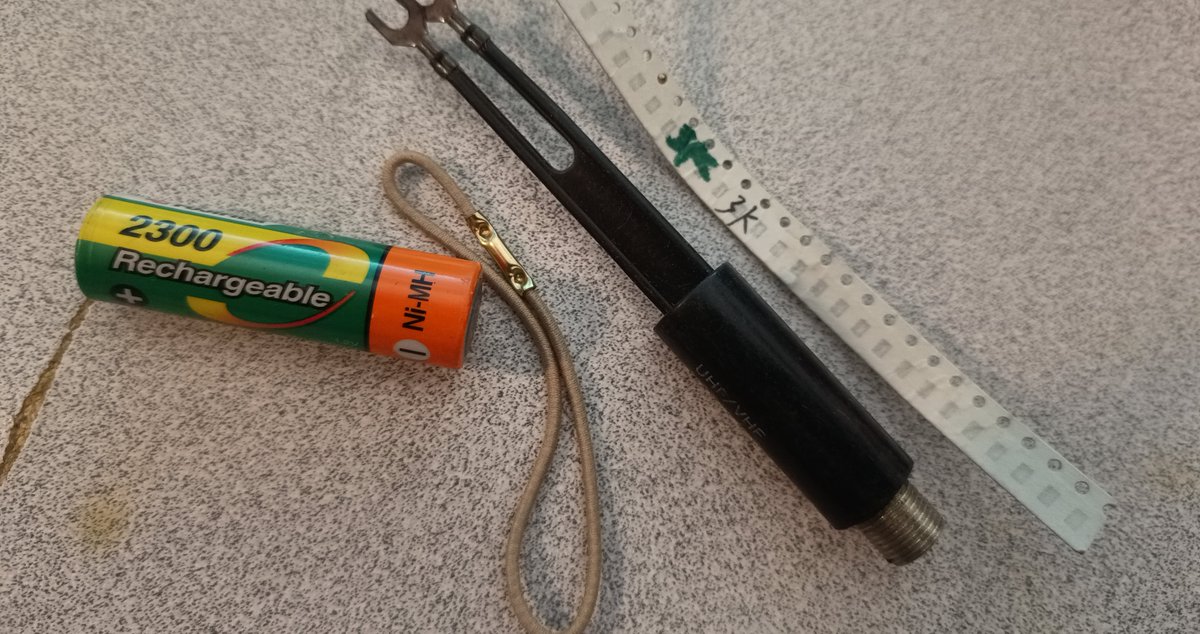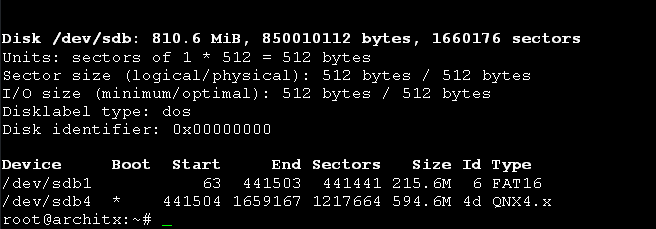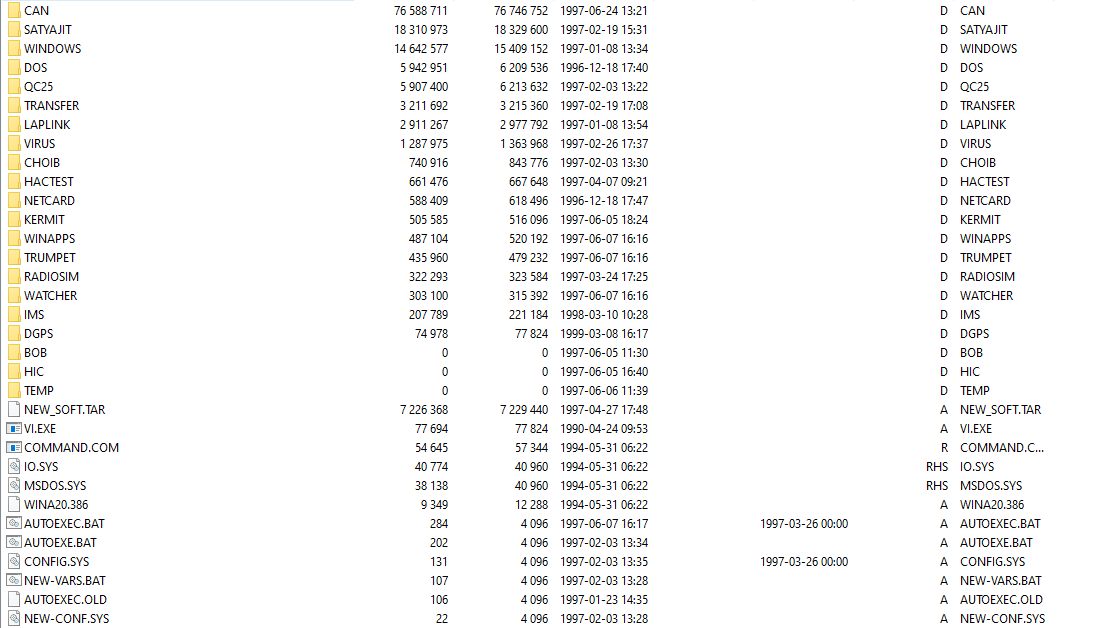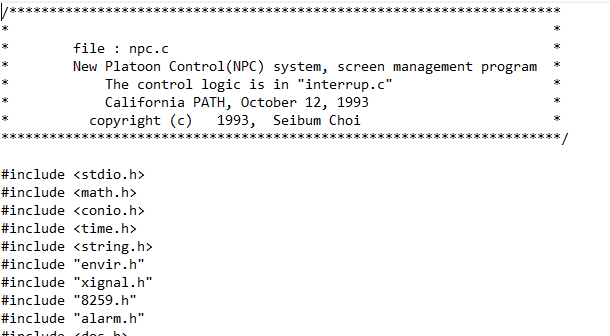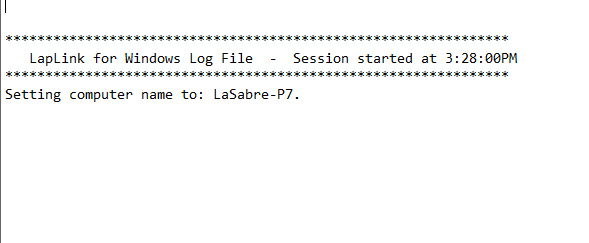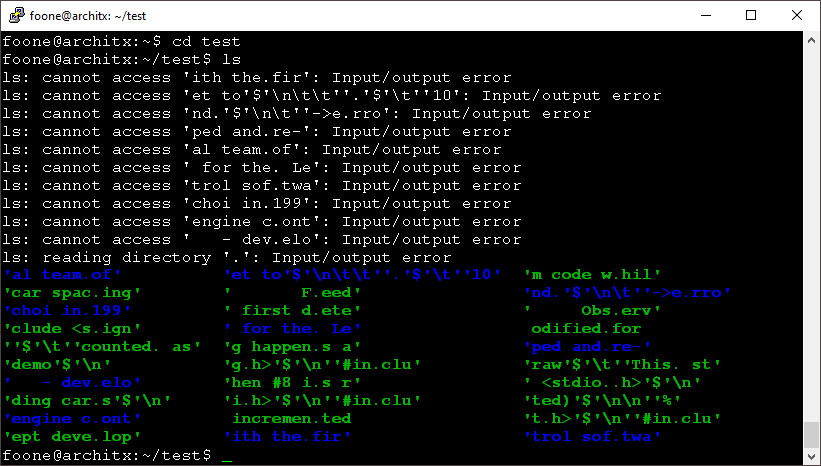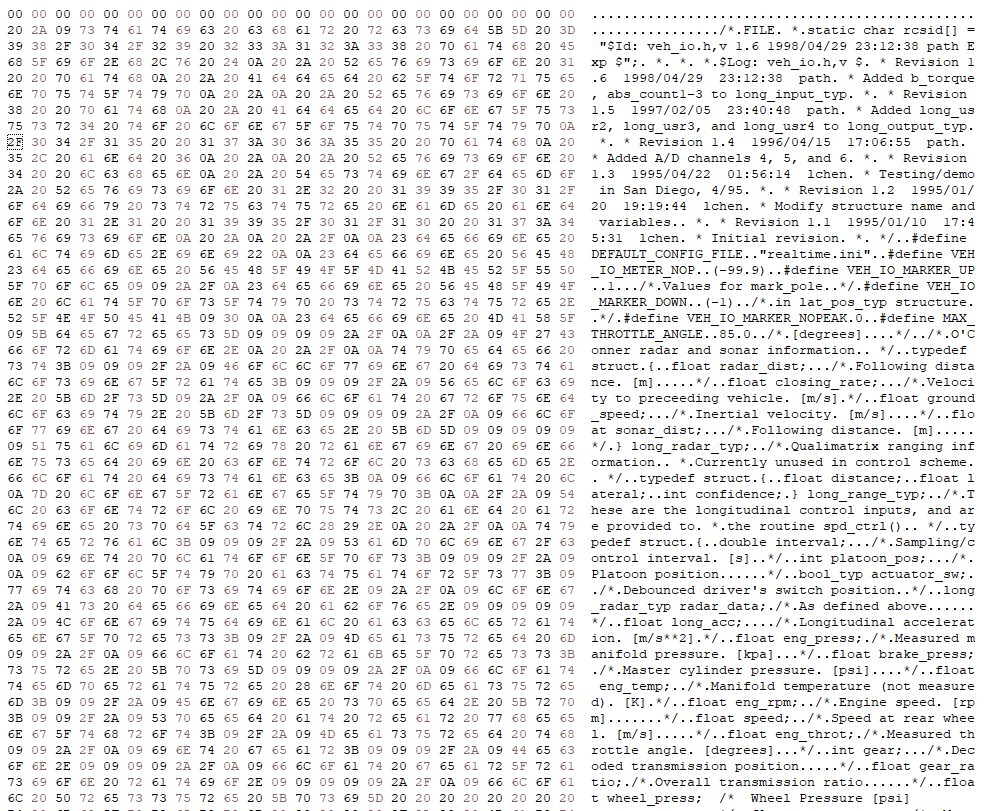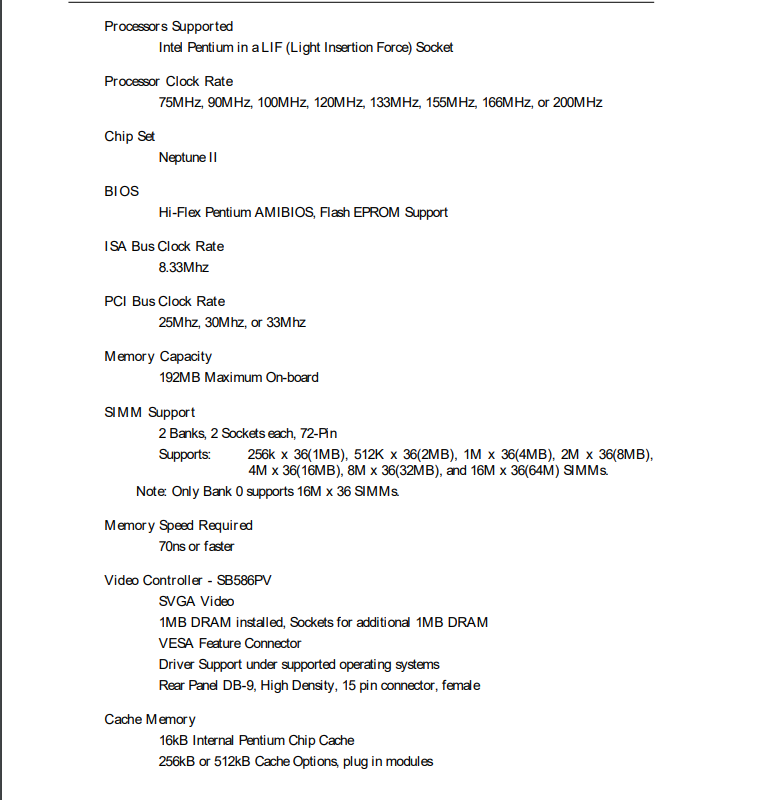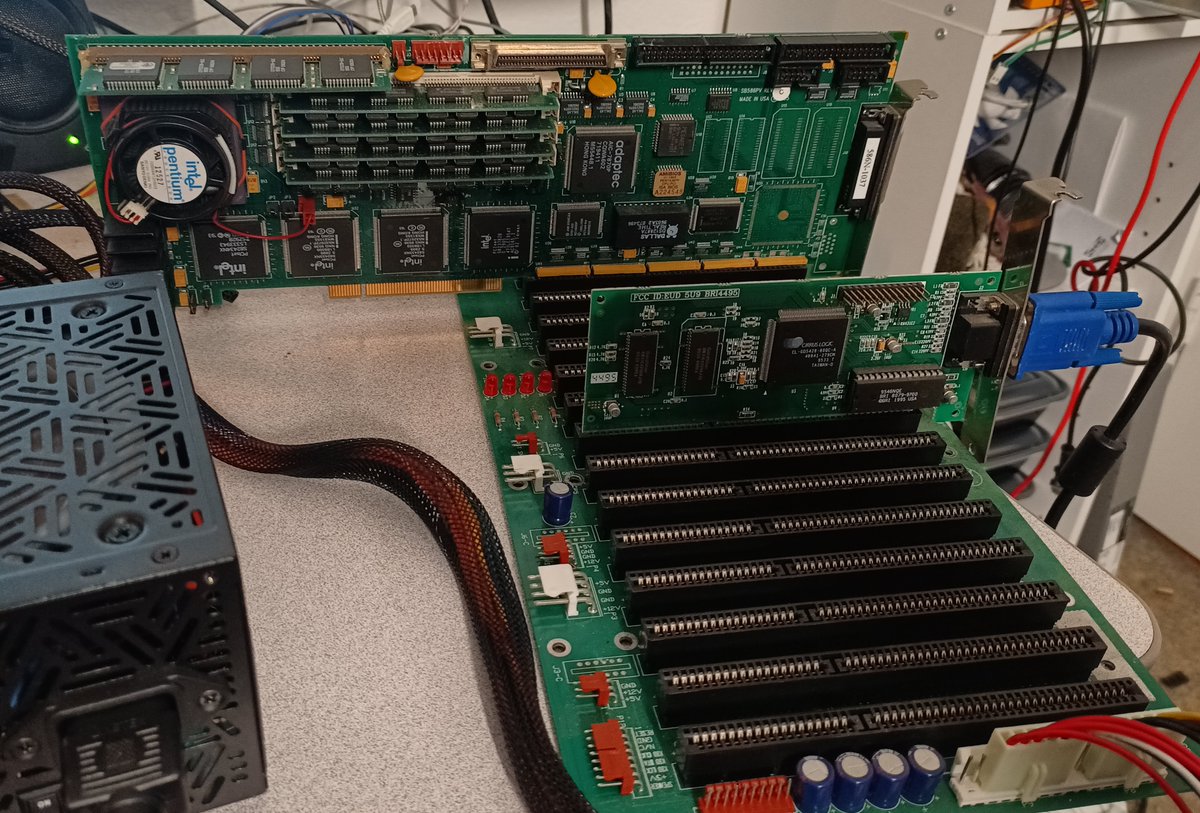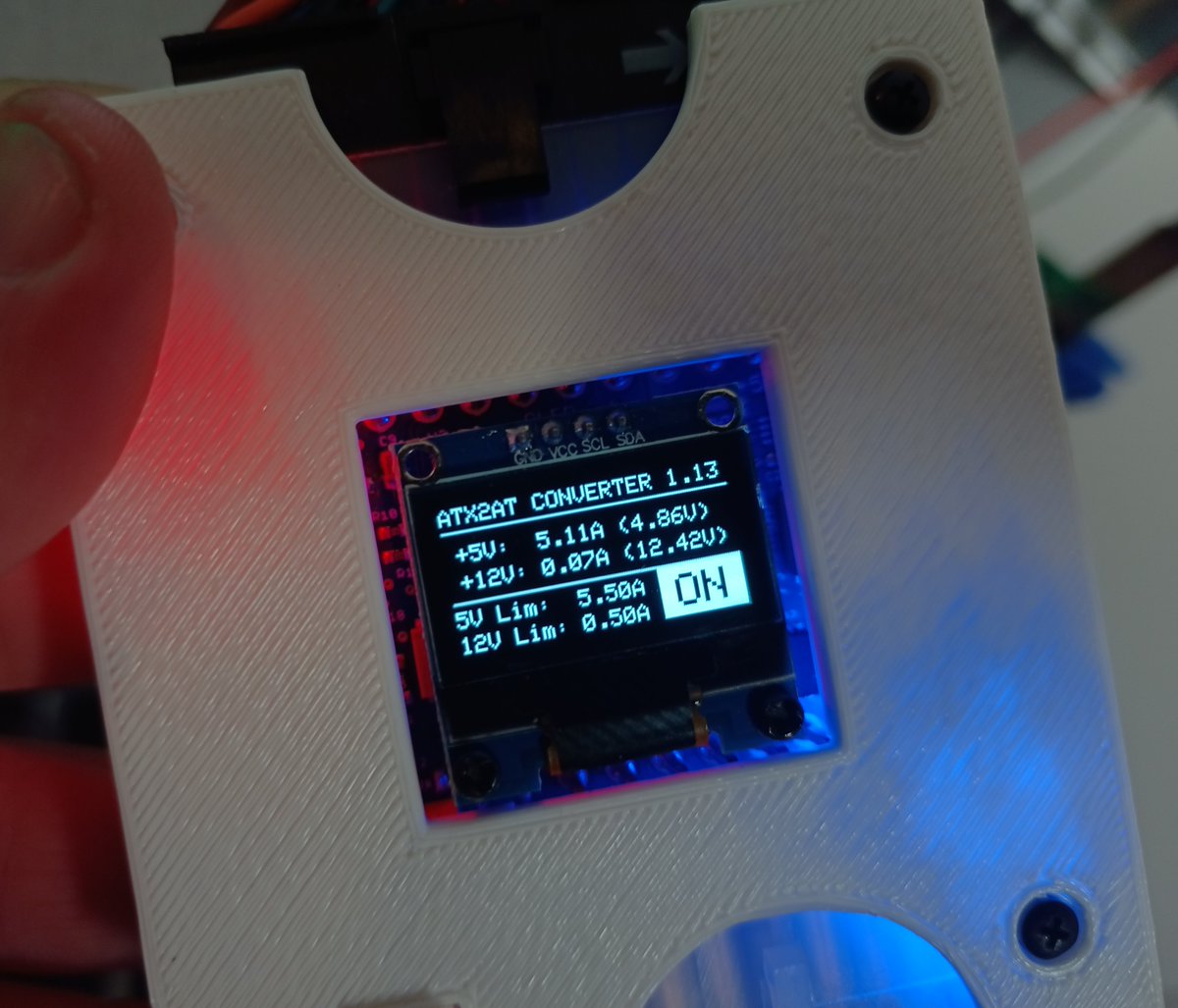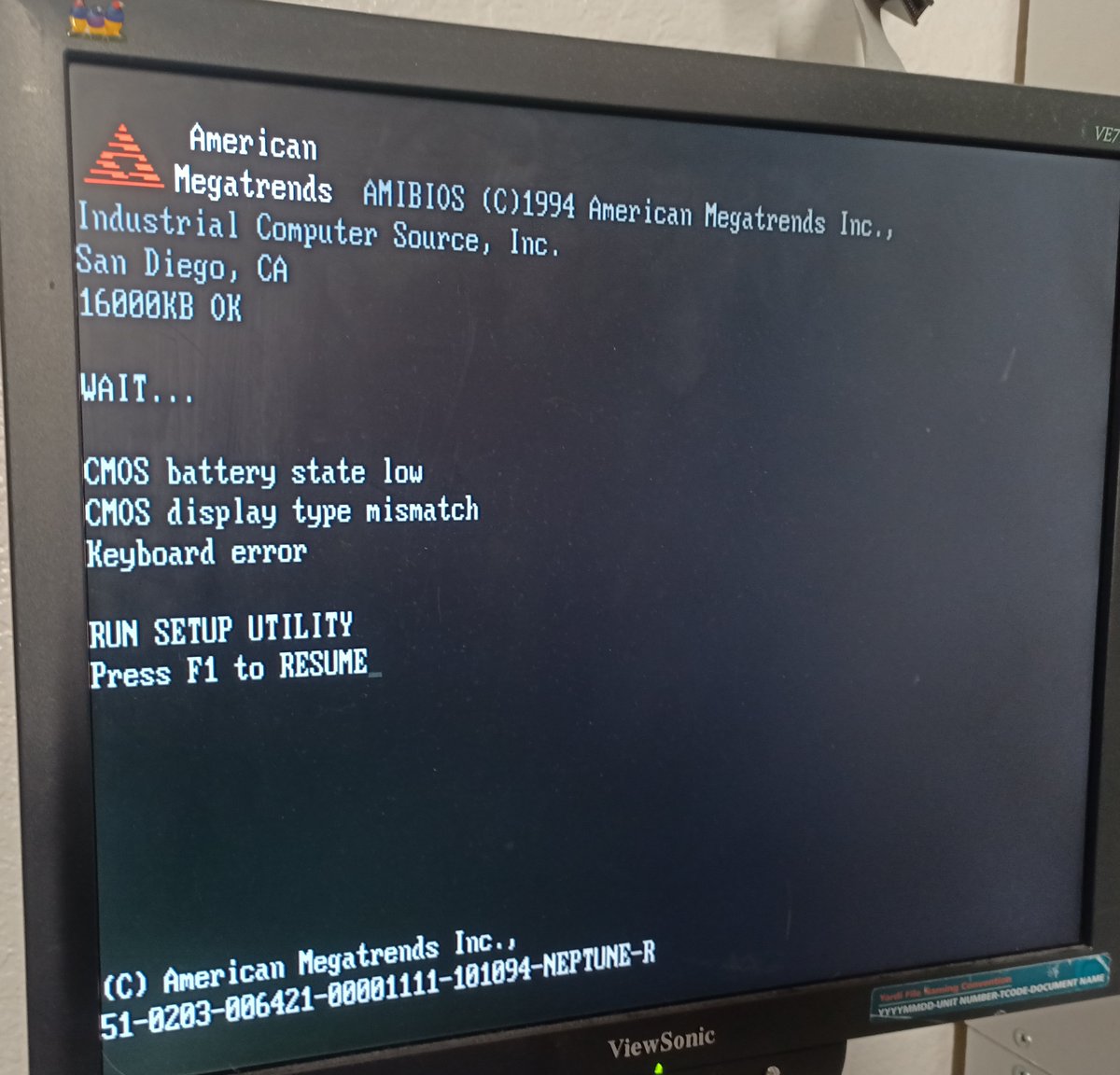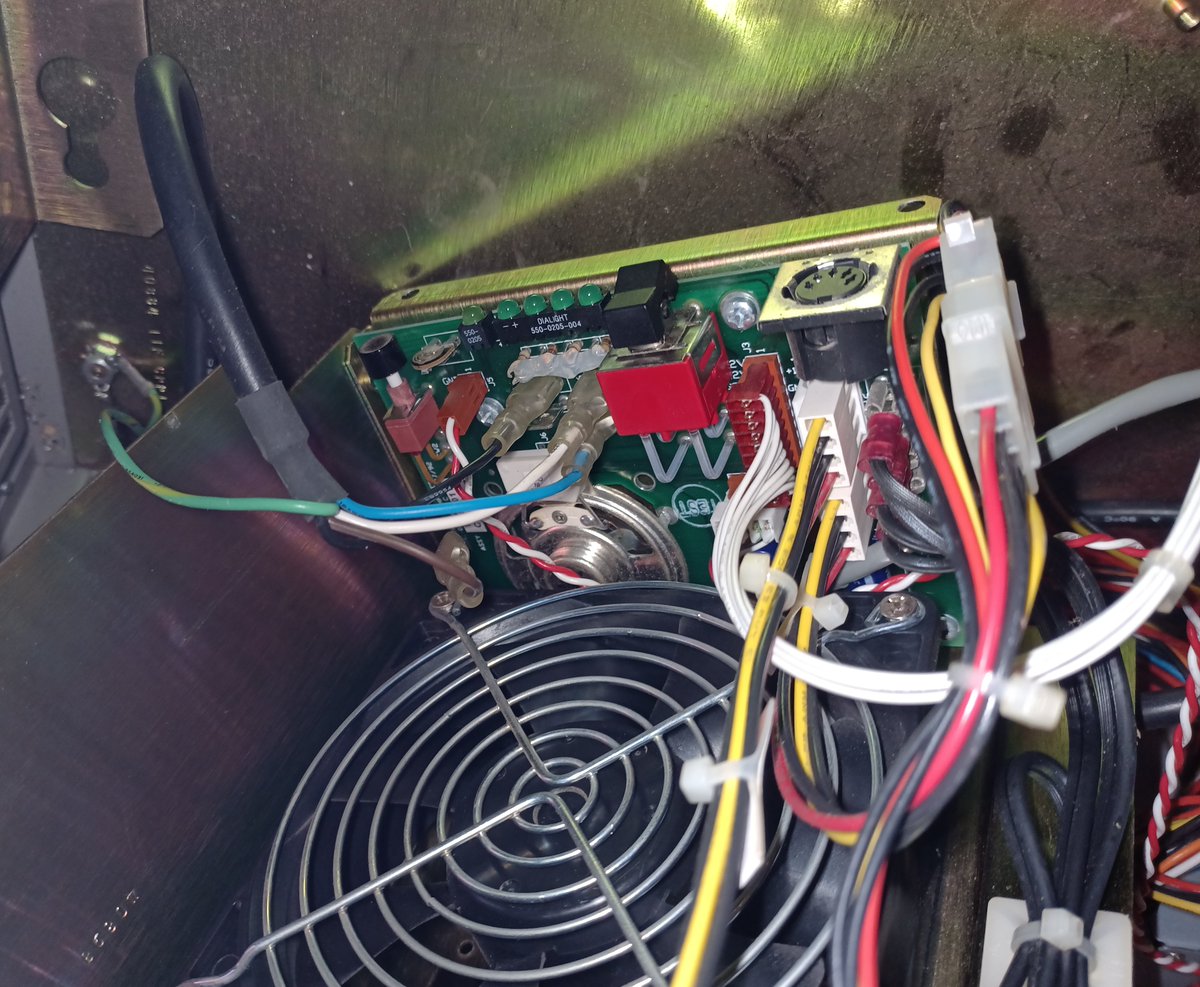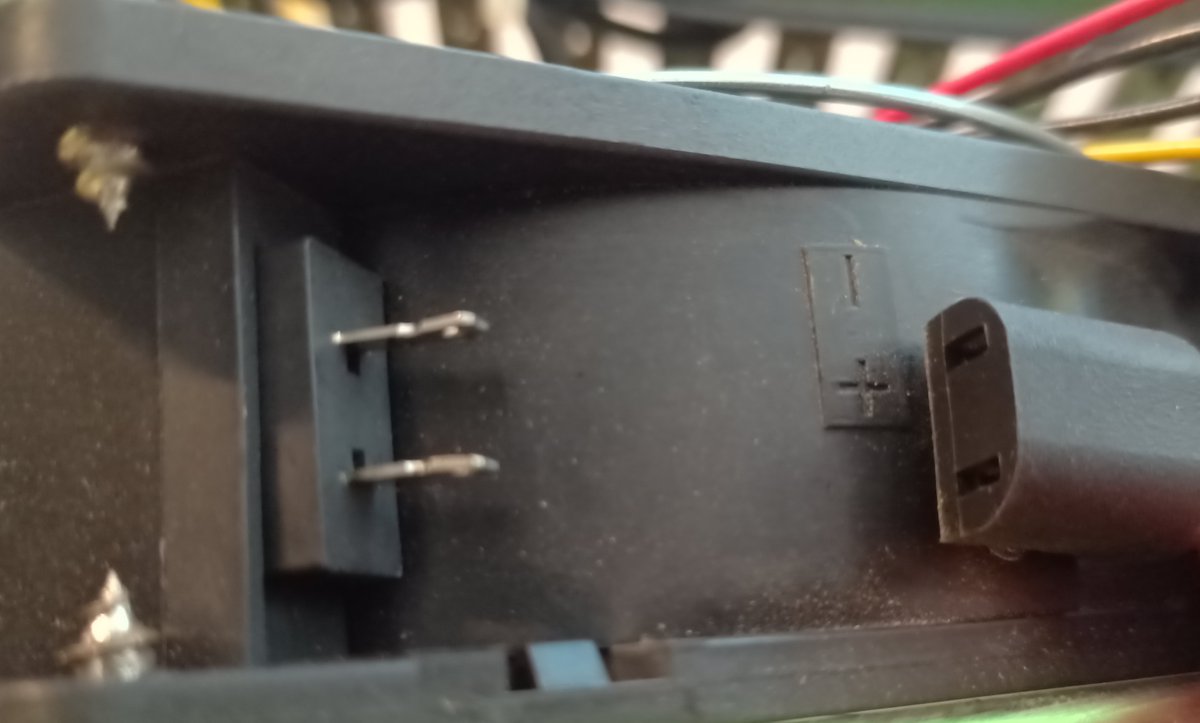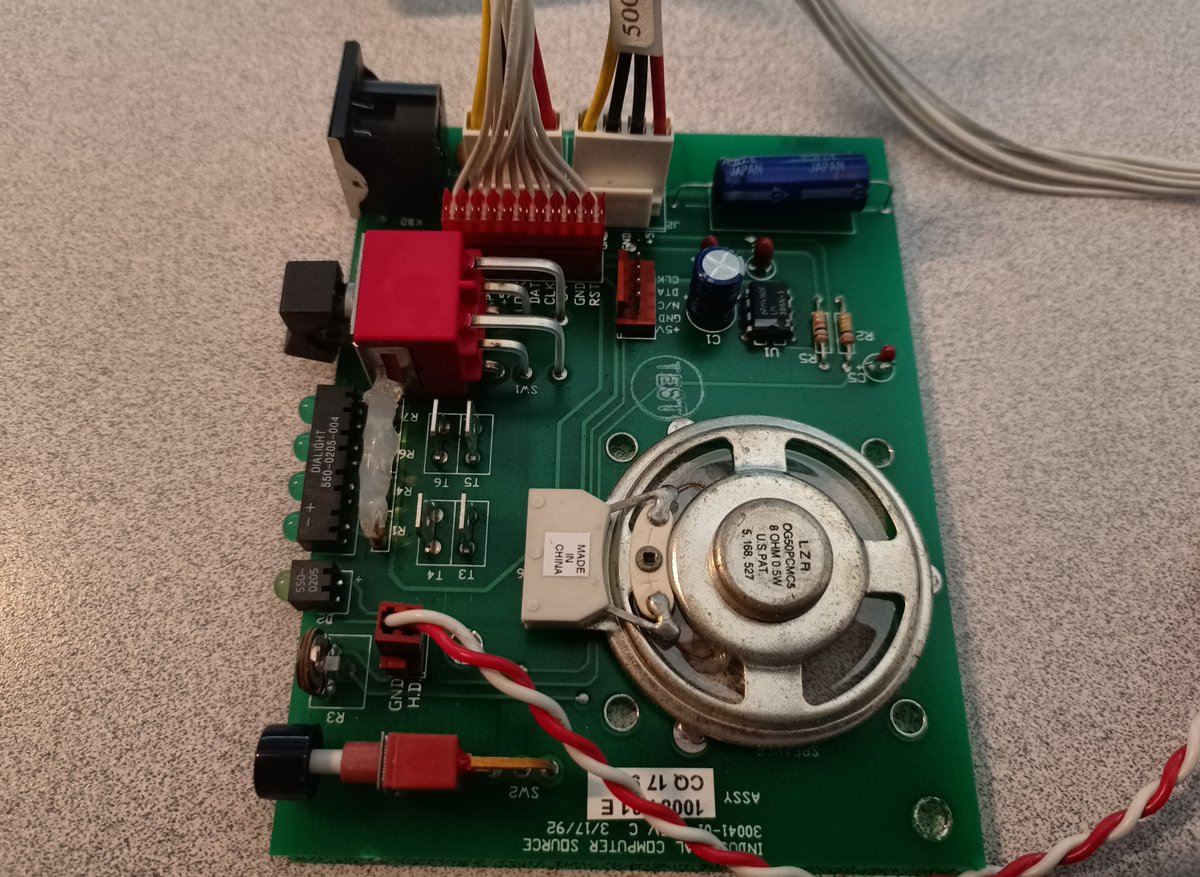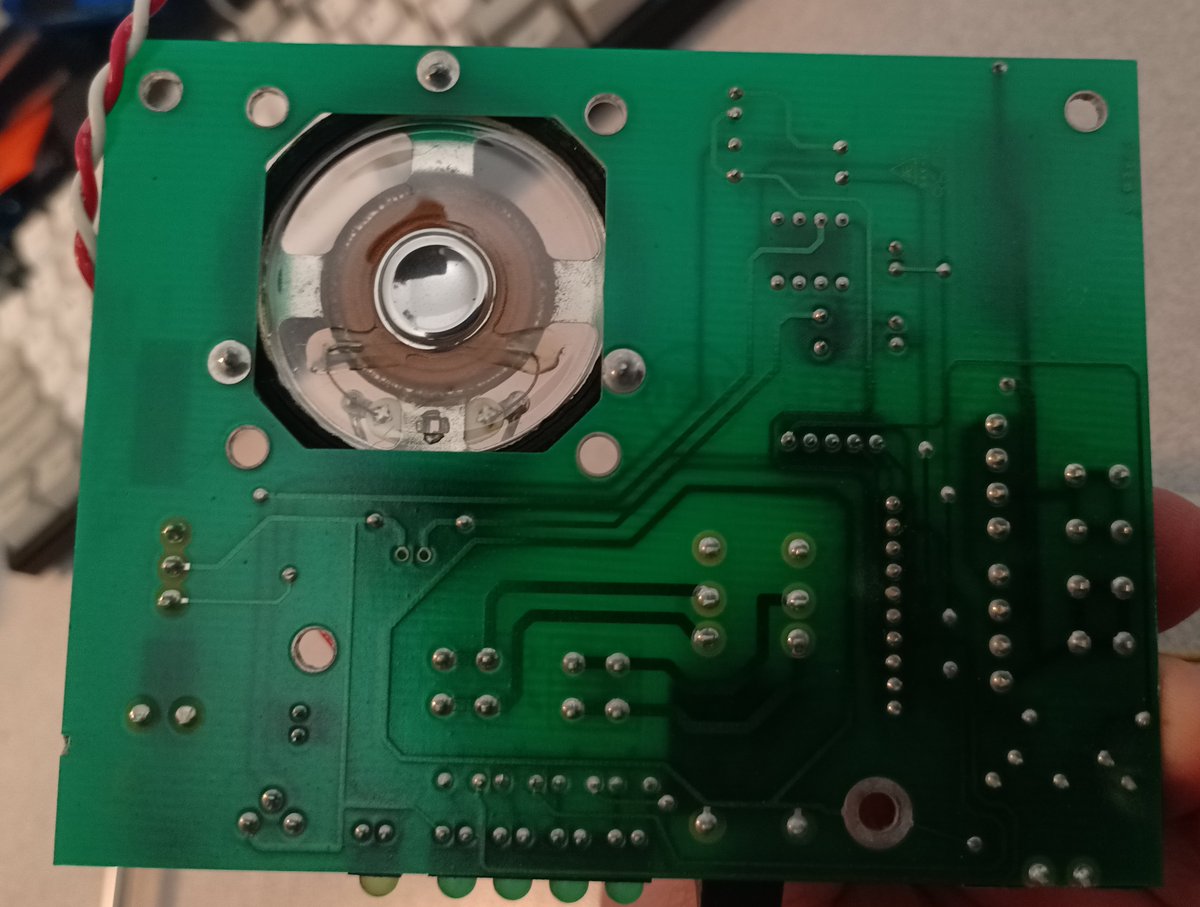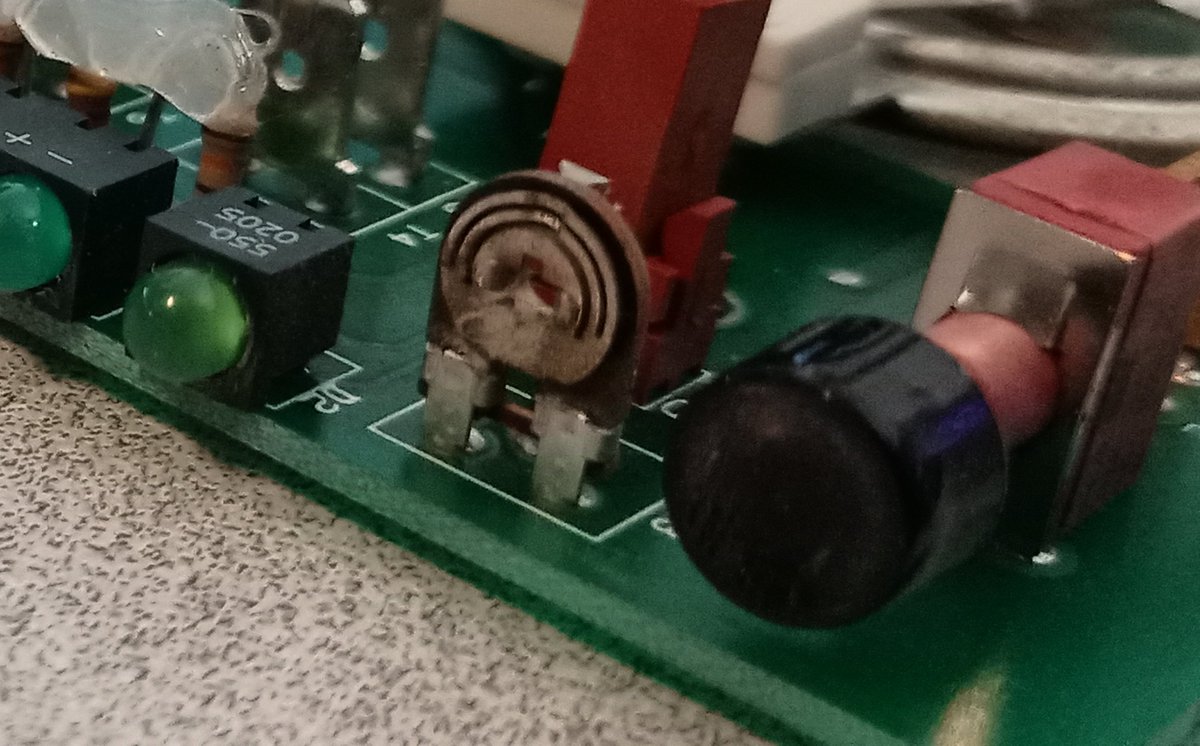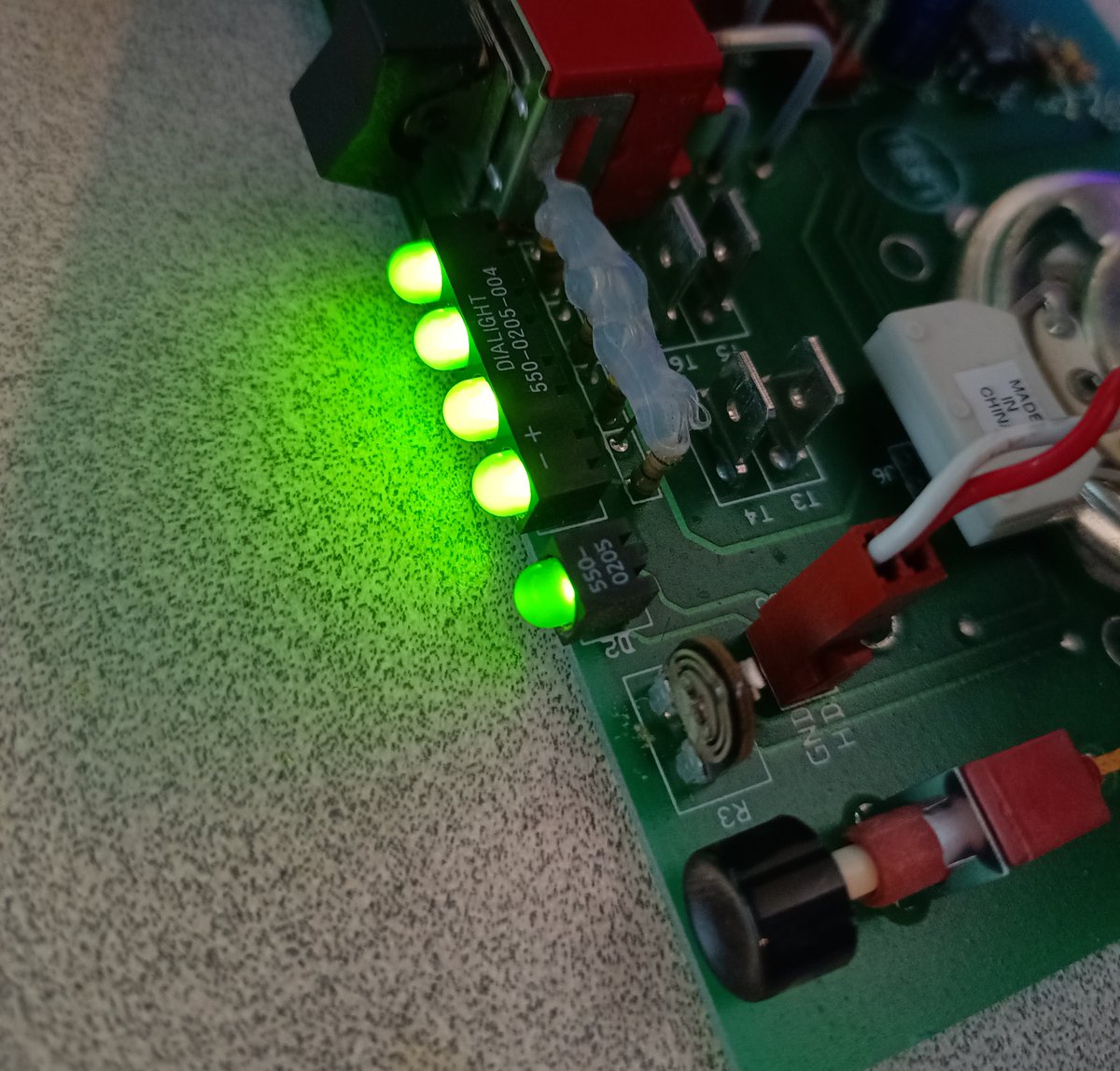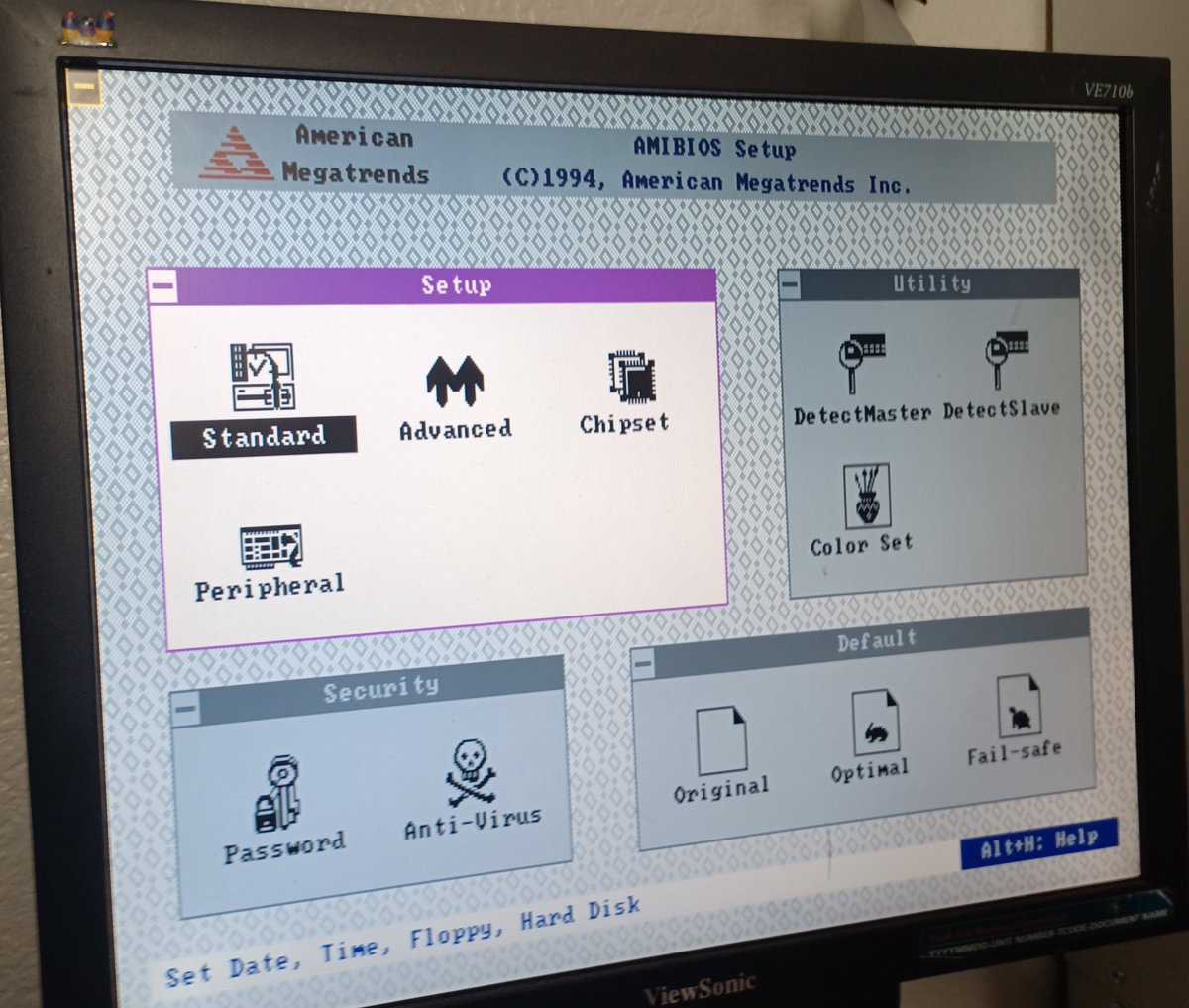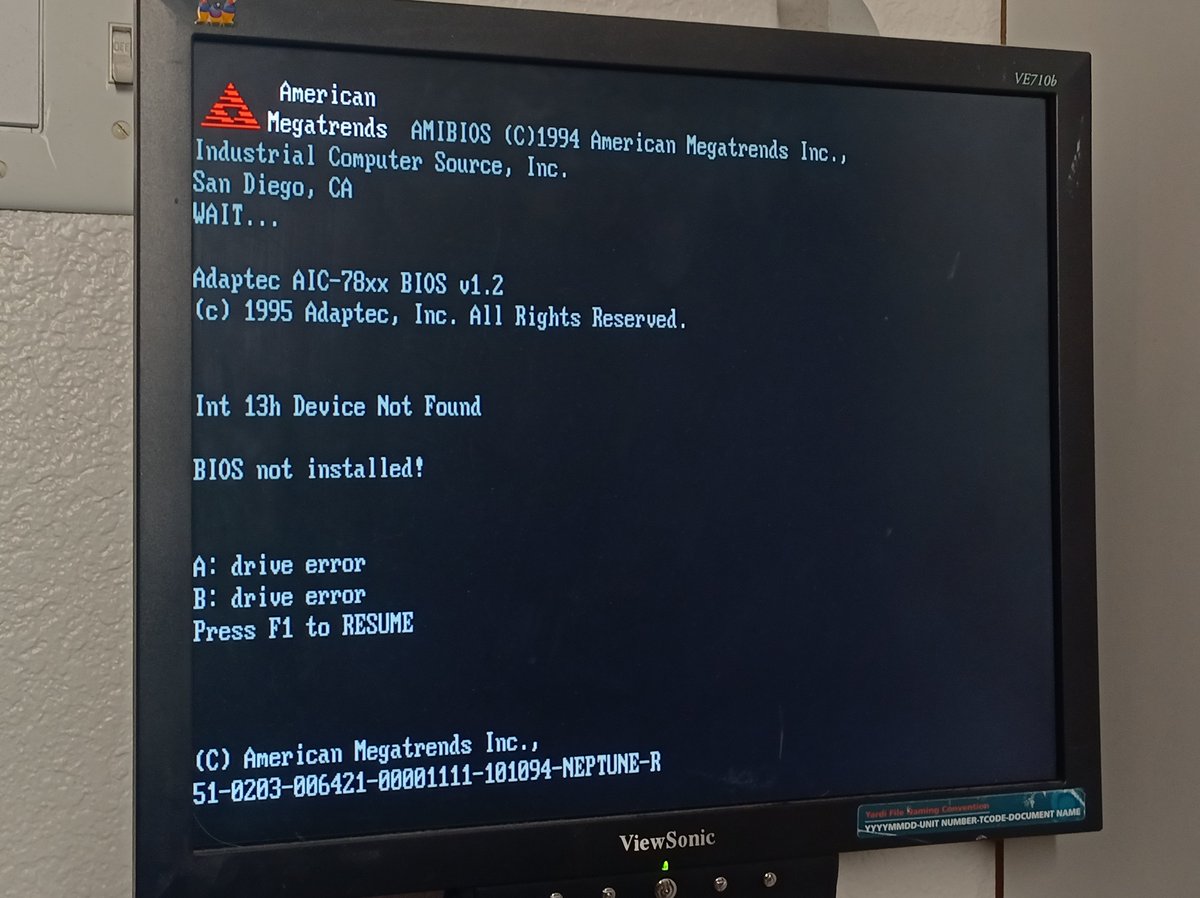OK, so I have another rack-mounted PC. This one is slightly less weird than the 286, and slightly more weird at the same time. It's complicated.
It's got an interesting front panel. You've got the floppy drive, a reset button, power switch, and separate LEDs for each of the power supply rails! Handy.
It's also got a floppy drive connector (AT type), which is rare to have on the front, especially since...
It's also got a floppy drive connector (AT type), which is rare to have on the front, especially since...
There's one on the back, too!
Now, the PC never supported more than one keyboard. So either there's something Special going on here... or you're only supposed to use one of these at a time
Now, the PC never supported more than one keyboard. So either there's something Special going on here... or you're only supposed to use one of these at a time
I thought the panel on the side of the front might have been access to hot-swapable hard drives, but NOPE! it's just an air filter.
It's apparntly the 7615-23V from Industrial Computer Source.
Property of GMC... Is that the General Motors Truck Company?
Property of GMC... Is that the General Motors Truck Company?
So, let's look at the back and see what we can see.
We've got two com ports, a parallel port (probably), and some weird ports. DB9-female and a... closed off port? huh.
Then the next one is probably SCSI or some weird industrial thing.
We've got two com ports, a parallel port (probably), and some weird ports. DB9-female and a... closed off port? huh.
Then the next one is probably SCSI or some weird industrial thing.
Then there's a VGA card, an ethernet card (with both cat5 and BNC connectors), and another SCSI-or-industrial adapter.
Anyway, time to look inside. The first thing I notice is that the closest card appears to be a Single Board Computer, so that's not a motherboard, it's a backplane. Neat.
Over here we've got the floppy drive and what looks like an IDE drive. So at least we don't have to worry about MFM today.
The hard drive is a surprisingly clean Quantum Trailblazer.
It's an 840AT (though you can't tell from the top), which is an 840mb drive.
It's an 840AT (though you can't tell from the top), which is an 840mb drive.
The backplane has a weird power connector where you connect the normal two AT power connectors but they are not aligned next to each other, there's gaps.
Weird. Scary.
Weird. Scary.
With the PSU removed you can see that the backplane isn't the simplest kind, there's some stuff that connects to it.
And that weird power connector over there
And that weird power connector over there
It's got places to route voltages, keyboard, and speaker around it.
I don't think it does anything with them... it just routes them
I don't think it does anything with them... it just routes them
So let's pull out the first card.
It's indeed an SBC! It's got ISA and PCI buses, though this backplane only uses the ISA.
It's a pentium, apparently. Looks like it's got SCSI, IDE, Floppy, and serial onboard.
It's indeed an SBC! It's got ISA and PCI buses, though this backplane only uses the ISA.
It's a pentium, apparently. Looks like it's got SCSI, IDE, Floppy, and serial onboard.
You might think this over here is the RAM.
It's not, not exactly.
This is a cache card! It adds external cache to the CPU.
It's got 4 of these CY7C178-8JCs. So this is a 256 kilobyte cache.
It's not, not exactly.
This is a cache card! It adds external cache to the CPU.
It's got 4 of these CY7C178-8JCs. So this is a 256 kilobyte cache.
So, the board has a BIOS with a date of 1993, and a Dallas realtime clock, which is definitely dead by now.
It's also soldered in, which is ARGH.
It's also soldered in, which is ARGH.
So let's move on.
The next board is this one.
This is the earwaxy one.
It's apparently by Leukhardt Systemelektronik? and possibly called the 320.01.5.200_A
The next board is this one.
This is the earwaxy one.
It's apparently by Leukhardt Systemelektronik? and possibly called the 320.01.5.200_A
So the back side shows that there was a bunch of bodge wires leading to the earwaxed connector.
And also some more info: The D-78532?
Tuttlingen is a town, so I think that's just where it's from. It says PC.ISA CAN4-1.01. CANbus, maybe?
And also some more info: The D-78532?
Tuttlingen is a town, so I think that's just where it's from. It says PC.ISA CAN4-1.01. CANbus, maybe?
So, the next card! It's not SCSI, it's a National Instruments thing. A PC-TIO-10.
That's a "timing and digital interface for the PC"
So it's used for measuring pulses and generating waves.
Neat.
That's a "timing and digital interface for the PC"
So it's used for measuring pulses and generating waves.
Neat.
Next up, a VGA card.
Cirrus-logic based, using the CL-GD5428 chip. No company name on it, maybe there's one on the back?
Cirrus-logic based, using the CL-GD5428 chip. No company name on it, maybe there's one on the back?
So in 1997, Carnegie Mellon University was working on something called an "Automated Highway Project" and they had the vehicles custom-built by General Motors.
So I think that's when this device dates to.
https://books.google.com/books?id=dzbTBwAAQBAJ&lpg=PA1&ots=BGmWVmSlwo&dq=%22automated%20highway%20project%22&pg=PA4#v=onepage&q&f=false
So I think that's when this device dates to.
https://books.google.com/books?id=dzbTBwAAQBAJ&lpg=PA1&ots=BGmWVmSlwo&dq=%22automated%20highway%20project%22&pg=PA4#v=onepage&q&f=false
So I've been hiding one attribute of this computer the whole time... a minor one, but an odd one.
You may have noticed hints in some of the images, and they get more obvious in this picture.
You may have noticed hints in some of the images, and they get more obvious in this picture.
IT IS COMPLETELY FULL OF SHIT
No, seriously.
All this crap came out of the computer.
And other than a couple of the screws, every single one of them had no reason to be in there.
All this crap came out of the computer.
And other than a couple of the screws, every single one of them had no reason to be in there.
You see how there's IDE cables and floppy cables in there?
Those aren't the ones it was using!
Those big screws? they won't fit this computer! That battery? Nowhere to put it!
Those aren't the ones it was using!
Those big screws? they won't fit this computer! That battery? Nowhere to put it!
really, why?
A rechargable AA battery, a hair tie, a 75-to-300-ohm balun, and a bunch of 3K SMD resistors.
A rechargable AA battery, a hair tie, a 75-to-300-ohm balun, and a bunch of 3K SMD resistors.
So what I think happened: I didn't remove the cover of this computer before taking these pictures. It didn't have one.
I think this thing was sitting around in a pile of electronics for the last two decades or so, with no cover on it.
It slowly accumulated random crap falling down from other stuff
It slowly accumulated random crap falling down from other stuff
eventually someone looked at it and thought "man that's old and crappy" and then sold it.
to me.
to me.
but yeah, apparently at one point it was used by Carnegie Mellon University, for some GM-affiliated 90s self-driving-car project.
I'll grab out the IDE harddrive imager and see if I can find anything fun on the hard drive.
Place your bets as to what OS it's running!
Place your bets as to what OS it's running!
I'm gonna guess Windows NT4
The drive spun up! that's a good first sign
Possible Windows For Workgroups, I can't easily tell from the filenames.
Anyway, copying...
Anyway, copying...
I still want to write a tool that you point at a drive and it figures out exactly what OS is installed on it.
Often it's easy to tell, but there's lots of edge cases:
Windows 3.0 vs 3.1 vs WfW 3.31
Win95 vs Win98
Different versions of DOS, different linuxes...
Often it's easy to tell, but there's lots of edge cases:
Windows 3.0 vs 3.1 vs WfW 3.31
Win95 vs Win98
Different versions of DOS, different linuxes...
so it'd be cool to go os_detect.py /dev/sdb1 and get back "Windows for Workgroups, 3.11, French version"
It finished copying! Zero errors. The hard drive seems fine.
oh god, it has a C:\\BOB directory
thankfully, it's empty.
We dodged a bullet. There's no Microsoft Bob installed here.
thankfully, it's empty.
We dodged a bullet. There's no Microsoft Bob installed here.
File dates seem to be in the 1996-1999 era, which matches with the 1997 date for the Automated Highways project.
CHOIB seems to be the source code to some of the system. It mentions PATH, dates back to 1993, and is credited to Seibum Choi
Seibum Choi is currently an Associate Professor at KAIST, South Korea, and their linkedin says that they worked at the UCB Institute of Transportation Studies in Berkeley, California, 1993-1997.
the really strange thing is that this isn't the first rack-mounted computer I've gotten that was owned by UCB.
And it's not the first computer I've gotten that was involved in the PATH project.
And it's not the first computer I've gotten that was involved in the PATH project.
This weird PC104 stack was used with the PATH system: https://twitter.com/Foone/status/1160557821269704706
continued here: https://twitter.com/Foone/status/1163344650763030528
And in 2019 I got a rack-mounted system with a built in trinitron that turned out to have been owned by UCB https://twitter.com/Foone/status/1180709519631900678
Another name in some of the files is Satyajit Patwardhan.
Satyajit is currently the CEO of ConnectMyEV, in San Jose, CA.
Their linked in confirms: They were a research engineer on California PATH, 1994-1997.
Satyajit is currently the CEO of ConnectMyEV, in San Jose, CA.
Their linked in confirms: They were a research engineer on California PATH, 1994-1997.
Looks like they were compiling the code with "Microsoft(R) QuickC(R) Compiler, Version 2.50".
That's from 1990, so pretty old by 1997... but I guess parts of the project started as early as 1993?
That's from 1990, so pretty old by 1997... but I guess parts of the project started as early as 1993?
They were also using Peter R. Tattam's Trumpet WinSock 2.0
Hopefully they registered it!
Hopefully they registered it!
update: they did not.
They're protecting the system with F-PROT version 2.25.
Because you DEFINITELY don't want to get a virus on a self-driving car.
It's also got a file_id.diz file, because apparently they downloaded it from a BBS.
Because you DEFINITELY don't want to get a virus on a self-driving car.
It's also got a file_id.diz file, because apparently they downloaded it from a BBS.
the CAN folder is apparently "CAN Emulator/Analyzer V2.00
by Softing GmbH 1993"
by Softing GmbH 1993"
The QNX partition is somewhat corrupt, or maybe linux QNX support isn't great for versions this old.
there's some source in there, from "lchen", which seems to be car-related stuff. Some dates are from 1998, so maybe the QNX stuff is later?
there we go! got the QNX working.
Apparently linux was trying to mount it as FAT, which... doesn't work.
Dates are 1996-2002!
Apparently linux was trying to mount it as FAT, which... doesn't work.
Dates are 1996-2002!
It's mainly the PATH code (which I've seen before, because of the PC104 stack!) and some more code to handle the data acquisition cards.
Some branches of the code named "snowplow" and "truck".
Some branches of the code named "snowplow" and "truck".
sadly, despite being an old version of QNX used for development, there's no copy of libgf on it.
I need that to run Doom on my remote control, damn it
Update:
Multiple people have pointed out that "D-78532" isn't a product name. It's the postal code for Tuttlingen. https://twitter.com/Foone/status/1343318038301474818
Multiple people have pointed out that "D-78532" isn't a product name. It's the postal code for Tuttlingen. https://twitter.com/Foone/status/1343318038301474818
and @RandyMongenel found the SBC board: It's the SB586P! Supports Pentiums from 75mhz to 200mhz, up to 192MB.
It powers on! 16mb of RAM. And of course, the CMOS battery has died.
And there's no keyboard, because I don't have anywhere to plug it in
And there's no keyboard, because I don't have anywhere to plug it in
So I resumed disassembling it.
There's a board inside the fan assembly that does the keyboard and speaker and such, which I need to get out to get keyboard access.
There's a board inside the fan assembly that does the keyboard and speaker and such, which I need to get out to get keyboard access.
Here's the board.
It combines a bunch of misc computer stuff: power switch, those 4 voltage lights, HD light, reset switch, speaker, keyboard interface.
It combines a bunch of misc computer stuff: power switch, those 4 voltage lights, HD light, reset switch, speaker, keyboard interface.
This adjustment here is interesting: It's hooked up to the PC speaker, and it's a volume control!
I've seen this done as a DIY hack, but never as a built in part of a system.
I've seen this done as a DIY hack, but never as a built in part of a system.
ALL LIGHTS ARE GO
(The power connectors for the switch aren't attached because I'm using an ATX power supply)
(The power connectors for the switch aren't attached because I'm using an ATX power supply)
Oh neat, it's using that pseudo-graphical AMIBIOS.
I believe this is actually a text mode: it just redefined some of the high-ascii characters to be graphics.
I believe this is actually a text mode: it just redefined some of the high-ascii characters to be graphics.
Unfortunately... I can't boot it. The problem is the dead CMOS battery.
Because this uses a Dallas DS12887A to store the CMOS settings, and it's dead. So I can go into the BIOS and configure the hard drive and such, then reboot, and it has forgotten it already.
Because this uses a Dallas DS12887A to store the CMOS settings, and it's dead. So I can go into the BIOS and configure the hard drive and such, then reboot, and it has forgotten it already.
Normally systems with separate CMOS storage and batteries will happily remember those settings until you power off, even if the battery is dead or missing.
Not DS12887s.
Not DS12887s.
so I'm gonna have to replace it, which is annoying because it's soldered to the board.
So I'll have to desolder that and add a socket.
So I'll have to desolder that and add a socket.

 Read on Twitter
Read on Twitter